Impact of M-Sand on Rheological, Mechanical, and Microstructural Properties of Self-Compacting Concrete
Abstract
:1. Introduction
2. Research Significance
3. Experimental Investigation
3.1. Materials
Particle Size Distribution
3.2. Mix Proportions
3.3. Rheological Properties
3.4. Hardened Properties
3.5. Microstructural Characteristics
4. Results and Discussion
4.1. Rheological Properties
4.1.1. Slump Flow and T500 Test
4.1.2. V-Funnel Test
4.1.3. L-Box Test
4.2. Mechanical Performance of SCC
4.2.1. Compressive Strength
4.2.2. Split Tensile Strength
4.2.3. Flexural Strength
4.2.4. Impact Resistance
4.2.5. Bond Strength
4.3. Microstructural Characterization
4.3.1. Scanning Electron Microscopy Analyses (SEM)
4.3.2. Energy-Dispersive X-ray Spectroscopy (EDX)
4.3.3. X-ray Diffraction (XRD)
4.3.4. Fourier Transform Infrared Spectroscopy (FTIR)
5. Conclusions
Author Contributions
Funding
Institutional Review Board Statement
Informed Consent Statement
Data Availability Statement
Acknowledgments
Conflicts of Interest
References
- Gnanaraj, S.C.; Chokkalingam, R.B.; Thankam, G.L.; Pothinathan, S. Durability properties of self-compacting concrete developed with fly ash and ultra fine natural steatite powder. J. Mater. Res. Technol. 2021, 13, 431–439. [Google Scholar] [CrossRef]
- Martins, M.A.; Barros, R.M.; da Silva, L.R.R.; dos Santos, V.C.; Lintz, R.C.; Gachet, L.A.; Melo, M.d.L.; Martinez, C.B. Durability indicators of high-strength self-compacting concrete with marble and granite wastes and waste foundry exhaust sand using electrochemical tests. Constr. Build. Mater. 2021, 317, 125907. [Google Scholar] [CrossRef]
- Irico, S.; Qvaeschning, D.; Mutke, S.; Deuse, T.; Gastaldi, D.; Canonico, F. Durability of high performance self-compacting concrete with granulometrically optimized slag cement. Constr. Build. Mater. 2021, 298, 123836. [Google Scholar] [CrossRef]
- Tufail, R.F.; Naeem, M.H.; Ahmad, J.; Waheed, H.; Majdi, A.; Farooq, D.; Maqsoom, A.; Butt, F. Evaluation of the fresh and mechanical properties of nano-engineered self compacting concrete containing graphite nano/micro platelets. Case Stud. Constr. Mater. 2022, 17, e01165. [Google Scholar] [CrossRef]
- Hasnain, M.H.; Javed, U.; Ali, A.; Zafar, M.S. Eco-friendly utilization of rice husk ash and bagasse ash blend as partial sand replacement in self-compacting concrete. Constr. Build. Mater. 2021, 273, 121753. [Google Scholar] [CrossRef]
- Ortega-López, V.; Faleschini, F.; Pellegrino, C.; Revilla-Cuesta, V.; Manso, J.M. Validation of slag-binder fiber-reinforced self-compacting concrete with slag aggregate under field conditions: Durability and real strength development. Constr. Build. Mater. 2022, 320, 126280. [Google Scholar] [CrossRef]
- Kapoor, K.; Singh, S.P.; Singh, B. Evaluating the durability properties of self compacting concrete made with coarse and fine recycled concrete aggregates. Eur. J. Environ. Civ. Eng. 2018, 24, 2383–2399. [Google Scholar] [CrossRef]
- Jain, A.; Choudhary, S.; Gupta, R.; Chaudhary, S.; Gautam, L. Effect of granite industry waste addition on durability properties of fly ash blended self-compacting concrete. Constr. Build. Mater. 2022, 340, 127727. [Google Scholar] [CrossRef]
- Choudhary, R.; Gupta, R.; Nagar, R. Impact on fresh, mechanical, and microstructural properties of high strength self-compacting concrete by marble cutting slurry waste, fly ash, and silica fume. Constr. Build. Mater. 2020, 239, 117888. [Google Scholar] [CrossRef]
- Liu, H.; Duan, G.; Wang, F.; Zhang, J.; Zhou, Y.; Feng, Y. Investigation on mechanical behaviors of Self-compacting con-crete. Constr. Build. Mater. 2022, 346, 128421. [Google Scholar] [CrossRef]
- Ramesh, B.; Gokulnath, V.; Krishnan, S.V. Detailed study of M-sand on the flexural properties of M-25 Grade Polypropylene Fibre reinforced self compacting concrete. Mater. Today Proc. 2020, 22, 1092–1096. [Google Scholar] [CrossRef]
- Ameri, F.; Shoaei, P.; Bahrami, N.; Vaezi, M.; Ozbakkaloglu, T. Optimum rice husk ash content and bacterial concentration in self-compacting concrete. Constr. Build. Mater. 2019, 222, 796–813. [Google Scholar] [CrossRef]
- Le, H.T.; Ludwig, H.-M. Effect of rice husk ash and other mineral admixtures on properties of self-compacting high performance concrete. Mater. Des. 2016, 89, 156–166. [Google Scholar] [CrossRef]
- Sathurshan, M.; Yapa, I.; Thamboo, J.; Jeyakaran, T.; Navaratnam, S.; Siddique, R.; Zhang, J. Untreated rice husk ash incorporated high strength self-compacting concrete: Properties and environmental impact assessments. Environ. Chall. 2021, 2, 100015. [Google Scholar] [CrossRef]
- Vijina, V.V.; Varghese, A.; Angitha, N.; Aswathy, S.; Mohan, K.; Shighil, C. Study on Self Compacting Concrete by Partial Replacement of Coarse Aggregate with Crushed Coconut Shell. Int. J. Res. Advent Technol. 2015, 6, 10–11. [Google Scholar] [CrossRef]
- Adebakin, I.H.; Gunasekaran, K.; Annadurai, R. Mechanical properties of self-compacting coconut shell concrete blended with fly ash. Asian J. Civ. Eng. 2019, 20, 113–124. [Google Scholar] [CrossRef]
- Kumar, V.P.; Gunasekaran, K.; Shyamala, T. Characterization Study on Coconut Shell Concrete with Partial Replacement of Cement by GGBS; Elsevier Ltd.: Amsterdam, The Netherlands, 2019; Volume 26. [Google Scholar] [CrossRef]
- Ting, T.; Rahman, M.; Lau, H. Lightweight Self-compacting Concrete Incorporating Oil Palm Shell. IOP Conf. Ser. Mater. Sci. Eng. 2019, 495, 012096. [Google Scholar] [CrossRef]
- Prayuda, H.; Saleh, F.; Maulana, T.I.; Monika, F. Fresh and mechanical properties of self-compacting concrete with coarse aggregate replacement using Waste of Oil Palm Shell. IOP Conf. Ser. Mater. Sci. Eng. 2018, 352, 012028. [Google Scholar] [CrossRef]
- Shettima, A.U.; Hussin, M.W.; Ahmad, Y.; Mirza, J. Evaluation of iron ore tailings as replacement for fine aggregate in concrete. Constr. Build. Mater. 2016, 120, 72–79. [Google Scholar] [CrossRef]
- Modani, P.O.; Vyawahare, M. Utilization of Bagasse Ash as a Partial Replacement of Fine Aggregate in Concrete. Procedia Eng. 2013, 51, 25–29. [Google Scholar] [CrossRef]
- Al-Jabri, K.S.; Hisada, M.; Al-Saidy, A.H.; Al-Oraimi, S. Performance of high strength concrete made with copper slag as a fine aggregate. Constr. Build. Mater. 2009, 23, 2132–2140. [Google Scholar] [CrossRef]
- Kavya, A.; Rao, A.V. Experimental investigation on mechanical properties of concrete with M-sand. Mater. Today Proc. 2020, 33, 663–667. [Google Scholar] [CrossRef]
- Pilegis, M.; Gardner, D.; Lark, R. An Investigation into the Use of Manufactured Sand as a 100% Replacement for Fine Aggregate in Concrete. Materials 2016, 9, 440. [Google Scholar] [CrossRef] [PubMed]
- Cheng, H.; Chen, P.; Rong, X.; Cao, S.; Zhao, W. Effect of steel fibre and manufactured sand on mechanical properties of alkali-activated slag green cementitious material after high temperature. Case Stud. Constr. Mater. 2023, 18, e01919. [Google Scholar] [CrossRef]
- Rojo-López, G.; González-Fonteboa, B.; Martínez-Abella, F.; González-Taboada, I. Rheology, durability, and mechanical performance of sustainable self-compacting concrete with metakaolin and limestone filler. Case Stud. Constr. Mater. 2022, 17, e01143. [Google Scholar] [CrossRef]
- Venkat, G.N.; Chandramouli, K.; Ahmed, E.; NagendraBabu, V. Comparative study on mechanical properties and quality of concrete by part replacement of cement with silica fume, metakaolin and GGBS by using M−Sand as fine aggregate. Mater. Today Proc. 2020, 43, 1874–1878. [Google Scholar] [CrossRef]
- IS 12269; IS (Indian Standard). Ordinary Portland Cement, 53 Grade—Specification. Bureau of Indian Standards: Delhi, Indian, 2013; Volume 6, pp. 141–142.
- IS:383; Specification for Coarse and Fine Aggregates from Natural Sources for Concrete. Bureau of Indian Standards: Delhi, Indian, 1970; pp. 1–24.
- BS 8110-1:1997; Structural Use of Concrete—Part 1: Code of Practice for Design and Construction. British Standards Institution: London, UK, 1997; p. 168.
- ASTM C494; Standard Specification for Chemical Admixtures for Concrete. ASTM: West Conshohocken, PA, USA, 2005; pp. 5–7.
- BS EN 12350-8:2010; BSI Standards Publication Testing Fresh Concrete. British Standards Institution: London, UK, 2010; p. 18.
- Kalirajan, S.; Vishnuram, B.G. Development of Self Compacting Concrete Using Manufactured Sand. Artic. Int. J. Earth Sci. Eng. 2014, 7, 987–992. Available online: www.cafetinnova.org (accessed on 23 March 2023).
- IS 516; Method of Tests for Strength of Concrete. Bureau of Indian Standards: Delhi, Indian, 1959; pp. 1–30.
- ACI Report 544.1R-96; Report on Fiber Reinforced Concrete. American Concrete Institute: Farmington Hills, MI, USA, 2002.
- ASTM-C234; Standard Test Method for Comparing Concretes on the Basis of the Bond Developed with Reinforcing Steel. American Concrete Institute: Farmington Hills, MI, USA, 1991.
- Krishnaraj, L.; Ravichandran, P. Investigation on grinding impact of fly ash particles and its characterization analysis in cement mortar composites. Ain Shams Eng. J. 2019, 10, 267–274. [Google Scholar] [CrossRef]
- BS EN 12350-8; Testing Fresh Concrete-Part 8: Self Compacting Concrete-Slump Flow Test. British Standards Institution: London, UK, 2010; pp. 5–8. Available online: https://www.en-standard.eu/din-en-12350-2-testing-fresh-concrete-part-2-slump-test/%0Ahttps://bsol.bsigroup.com/Home (accessed on 23 March 2023).
- ASTM C39-01; Standard Test Method for Compressive Strength of Cylindrical Concrete Specimens 1. American Concrete Institute: Farmington Hills, MI, USA, 2003; Volume i, pp. 1–5. [CrossRef]
- Beretka, J.; Marroccoli, M.; Sherman, N.; Valenti, G. The influence of C4A3 content and WS ratio on the performance of calcium sulfoaluminate-based cements. Cem. Concr. Res. 1996, 26, 1673–1681. [Google Scholar] [CrossRef]
- Ding, X.; Li, C.; Xu, Y.; Li, F.; Zhao, S. Experimental study on long-term compressive strength of concrete with manufactured sand. Constr. Build. Mater. 2016, 108, 67–73. [Google Scholar] [CrossRef]
- Zimar, Z.; Samarawickrama, G.K.P.N.; Karunarathna, W.S.D.; Jayakody, S. Effect of Manufactured Sand as a Replacement for Fine Aggregates in Concrete. In Proceedings of the 8th International Conference on Structural Engineering and Construction Management, Kandy, Sri Lanka, 7 December 2017; pp. 1–6. [Google Scholar]
- ASTM C496/C496M−17; Standard Test Method for Splitting Tensile Strength of Cylindrical Concrete Specimens ASTM C-496. American Concrete Institute: Farmington Hills, MI, USA, 2011; pp. 1–5. Available online: https://webstore.ansi.org/standards/astm/astmc496c496m17 (accessed on 23 March 2023).
- IS 5816-1999; Indian Standard Splitting Tensile Strength of Concrete-Method of Test. Bureau of Indian Standards: Delhi, Indian, 1999; pp. 1–14.
- Ganga, V.; Selvan, S.S. Influence of expansive cement on rheological, strength performance and morphological characteristics of self-compacting concrete. Constr. Build. Mater. 2022, 368, 130407. [Google Scholar] [CrossRef]
- Magudeaswaran, P.; Eswaramoorthi, P. High Performance Concrete Using M Sand. Asian J. Res. Soc. Sci. Humanit. 2016, 6, 372–386. [Google Scholar] [CrossRef]
- Test, C.C.; Drilled, T.; Concrete, C. Standard Test Method for Flexural Strength of Concrete (Using Simple Beam with Third-Point Loading). Hand 2010, C78-02, 1–4. [Google Scholar]
- Seabrook, P.T.; Balck, L.F.; Bawa, K.S.; Bortz, S.A.; Chynoweth, G.L.; Crom, T.R.; Litvin, A. State-Of-The-Art Report on Fiber Reinforced Shotcrete. Concr. Int. 1984, 6, 15–27. [Google Scholar]
- Gunasekaran, K.; Kumar, P.; Lakshmipathy, M. Mechanical and bond properties of coconut shell concrete. Constr. Build. Mater. 2011, 25, 92–98. [Google Scholar] [CrossRef]
- Faye, P.N.; Ye, Y.; Diao, B. Bond Effects between Concrete and Steel Bar Using Different Diameter Bars and Different Initial Crack Width. Adv. Civ. Eng. 2017, 2017, 8205081. [Google Scholar] [CrossRef]
- Gupta, N.; Siddique, R. Strength and micro-structural properties of self-compacting concrete incorporating copper slag. Constr. Build. Mater. 2019, 224, 894–908. [Google Scholar] [CrossRef]
- Singh, G.; Siddique, R. Strength properties and micro-structural analysis of self-compacting concrete made with iron slag as partial replacement of fine aggregates. Constr. Build. Mater. 2016, 127, 144–152. [Google Scholar] [CrossRef]
- Singh, N.; Singh, S.P. Validation of carbonation behavior of self compacting concrete made with recycled aggregates using microstructural and crystallization investigations. Eur. J. Environ. Civ. Eng. 2020, 24, 2187–2210. [Google Scholar] [CrossRef]
- Chander, S.P.; Manivel, S.; Gunasekaran, K.; Jothiswaran, A. An experimental investigation of partial replacement of cement using micro silica and fly ash in production of coconut shell concrete. Int. J. Civ. Eng. Technol. 2017, 8, 1851–1859. [Google Scholar]
- Vidyadhara, V.; Saurabh, B.; Ranganath, R.V. Impact of pond ash as fine aggregate on mechanical and microstructural properties of geopolymer concrete. Mag. Civ. Eng. 2022, 113, 11305. [Google Scholar] [CrossRef]
- Siddique, S.; Shrivastava, S.; Chaudhary, S. Influence of Ceramic Waste as Fine Aggregate in Concrete: Pozzolanic, XRD, FT-IR, and NMR Investigations. J. Mater. Civ. Eng. 2018, 30, 04018227. [Google Scholar] [CrossRef]
- Nagaratnam, B.H.; Mannan, M.A.; Rahman, M.E.; Mirasa, A.K.; Richardson, A.; Nabinejad, O. Strength and microstructural characteristics of palm oil fuel ash and fly ash as binary and ternary blends in Self-Compacting concrete. Constr. Build. Mater. 2019, 202, 103–120. [Google Scholar] [CrossRef]


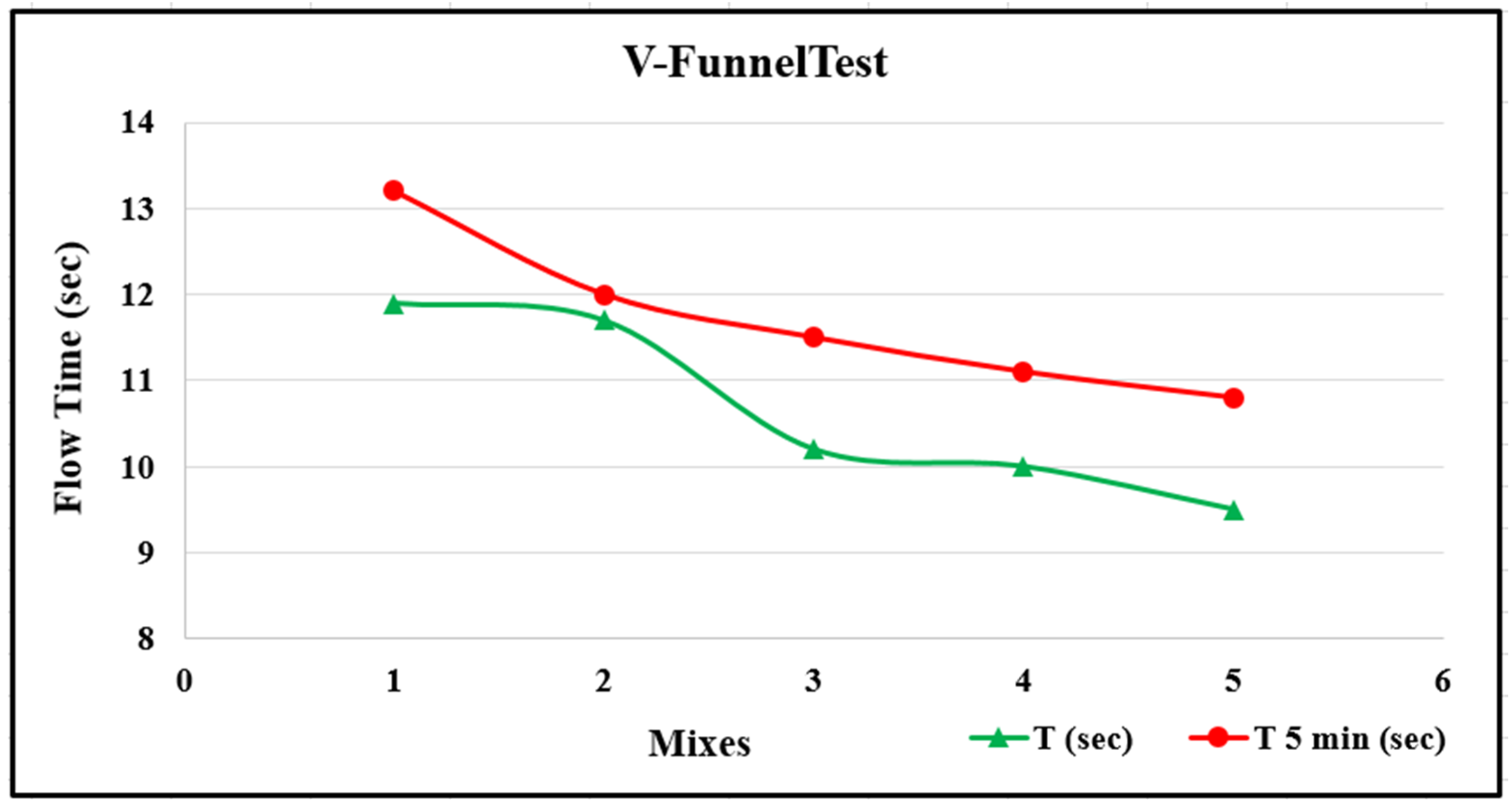



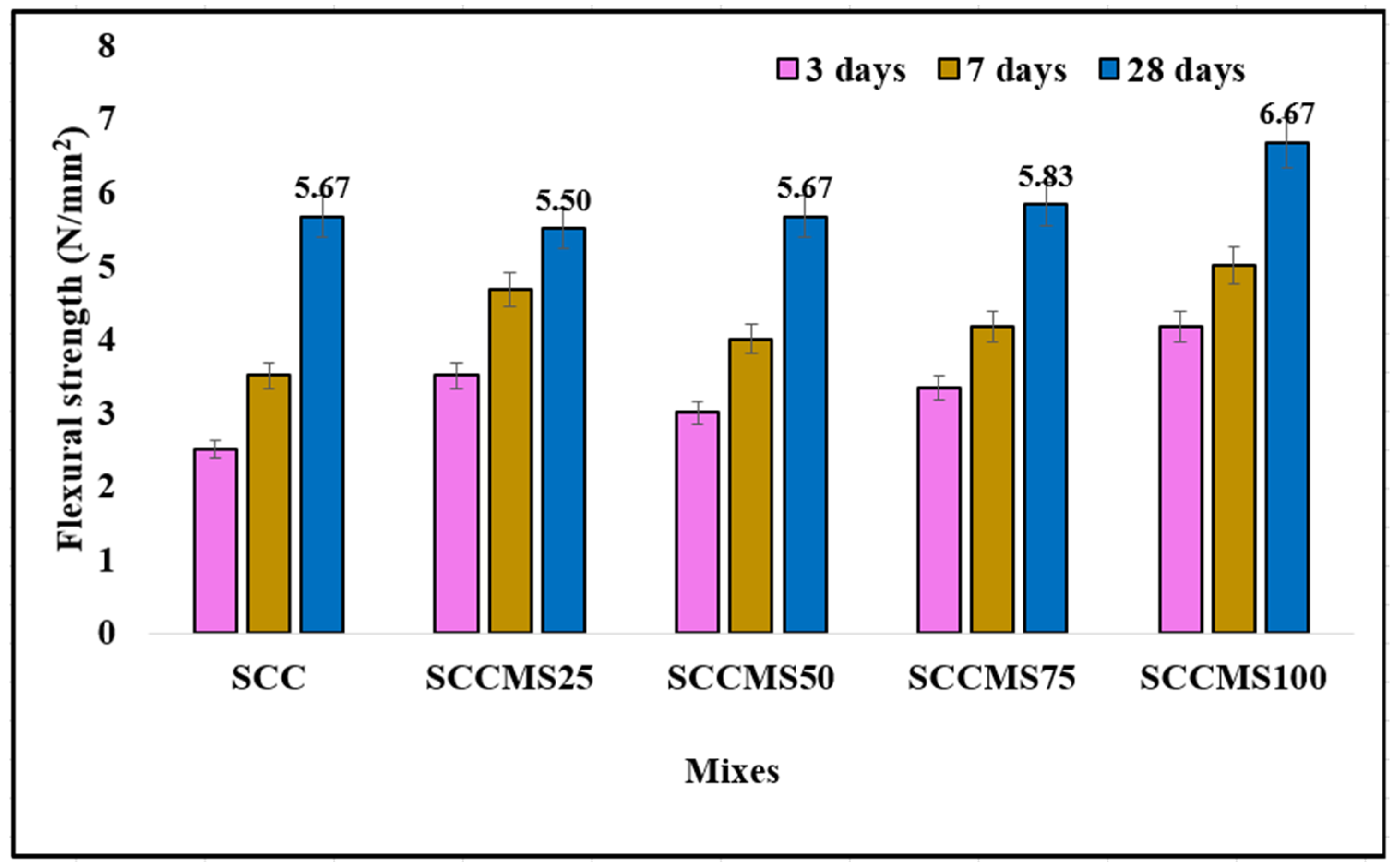
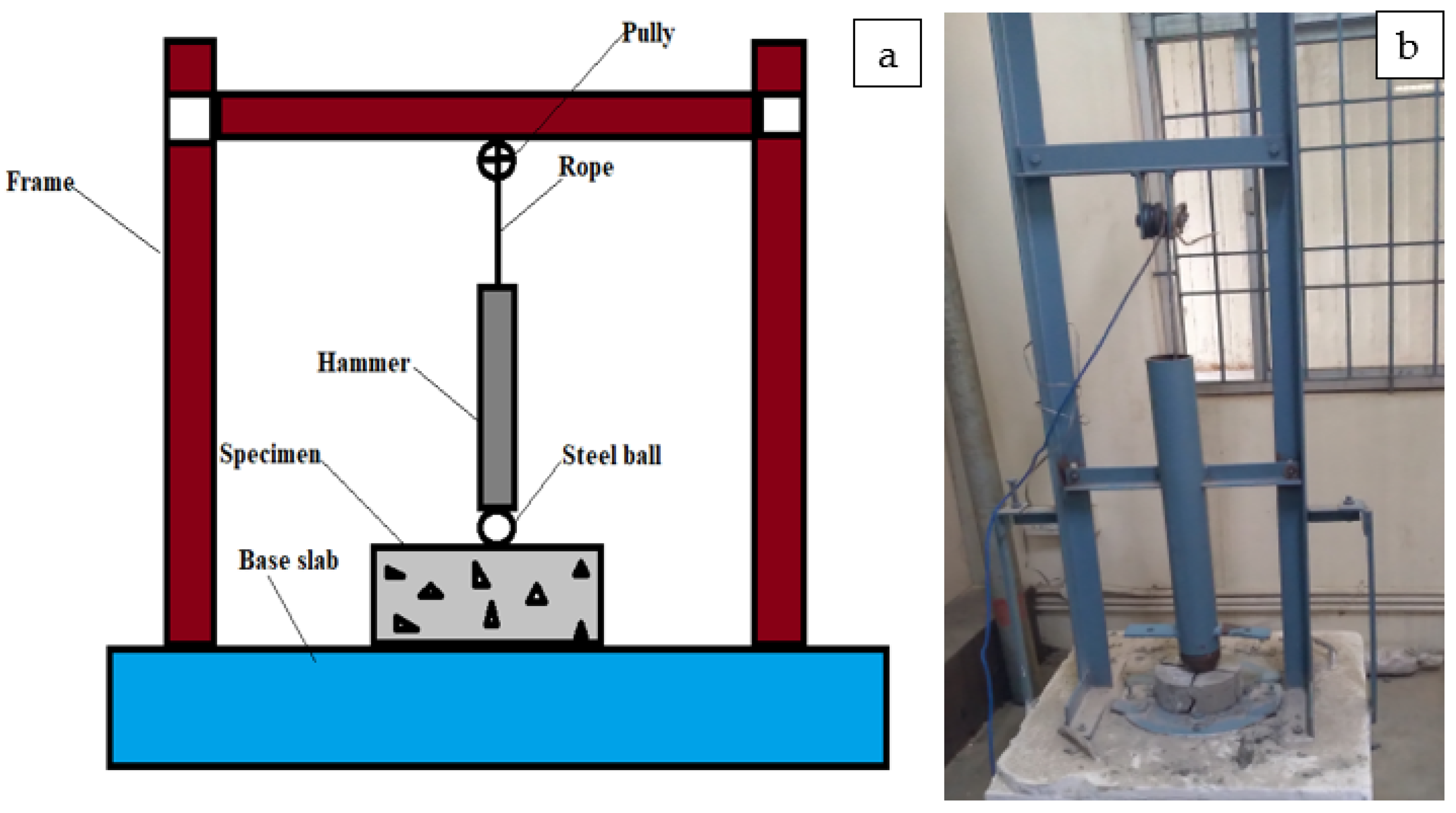

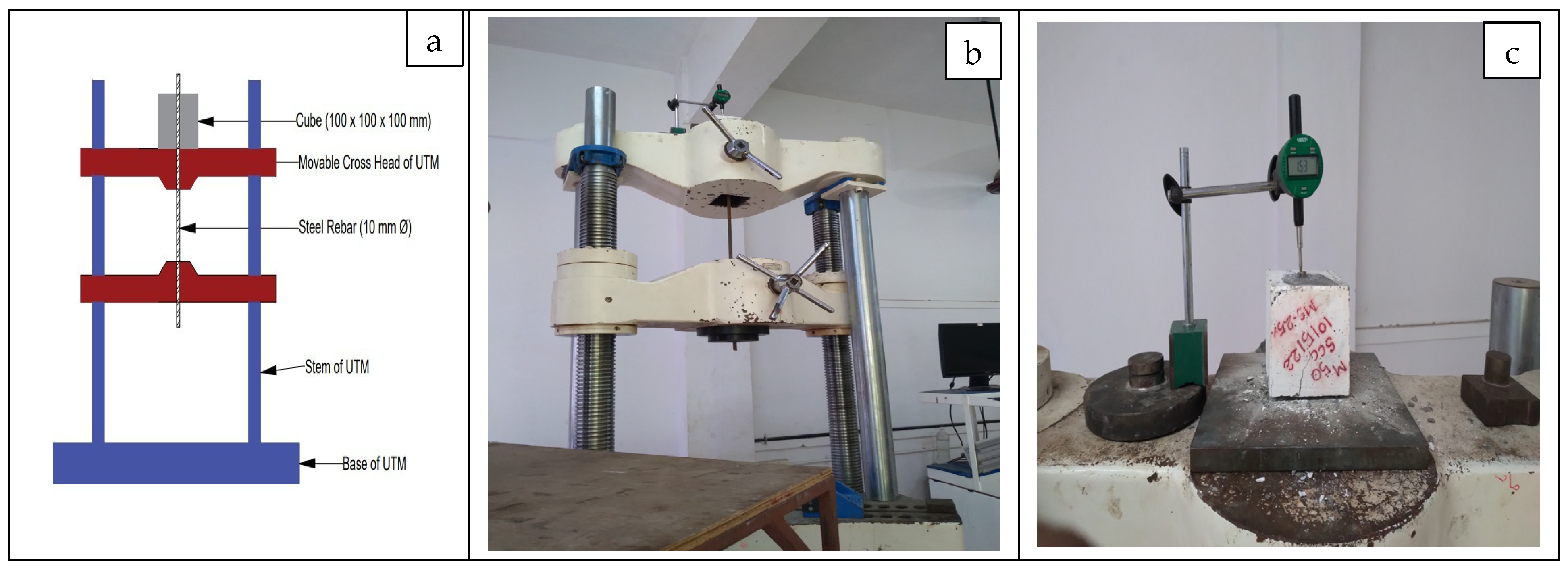
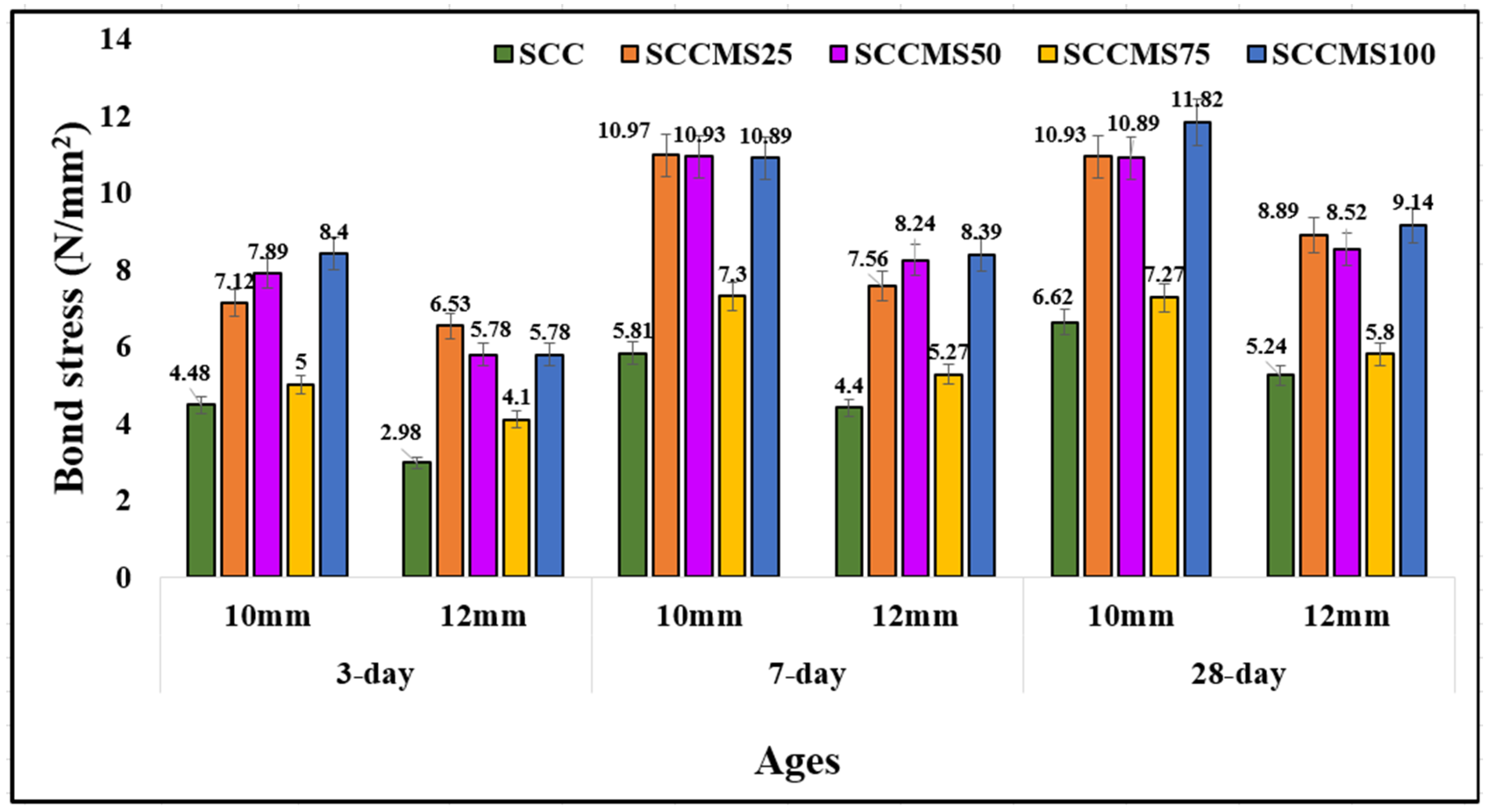
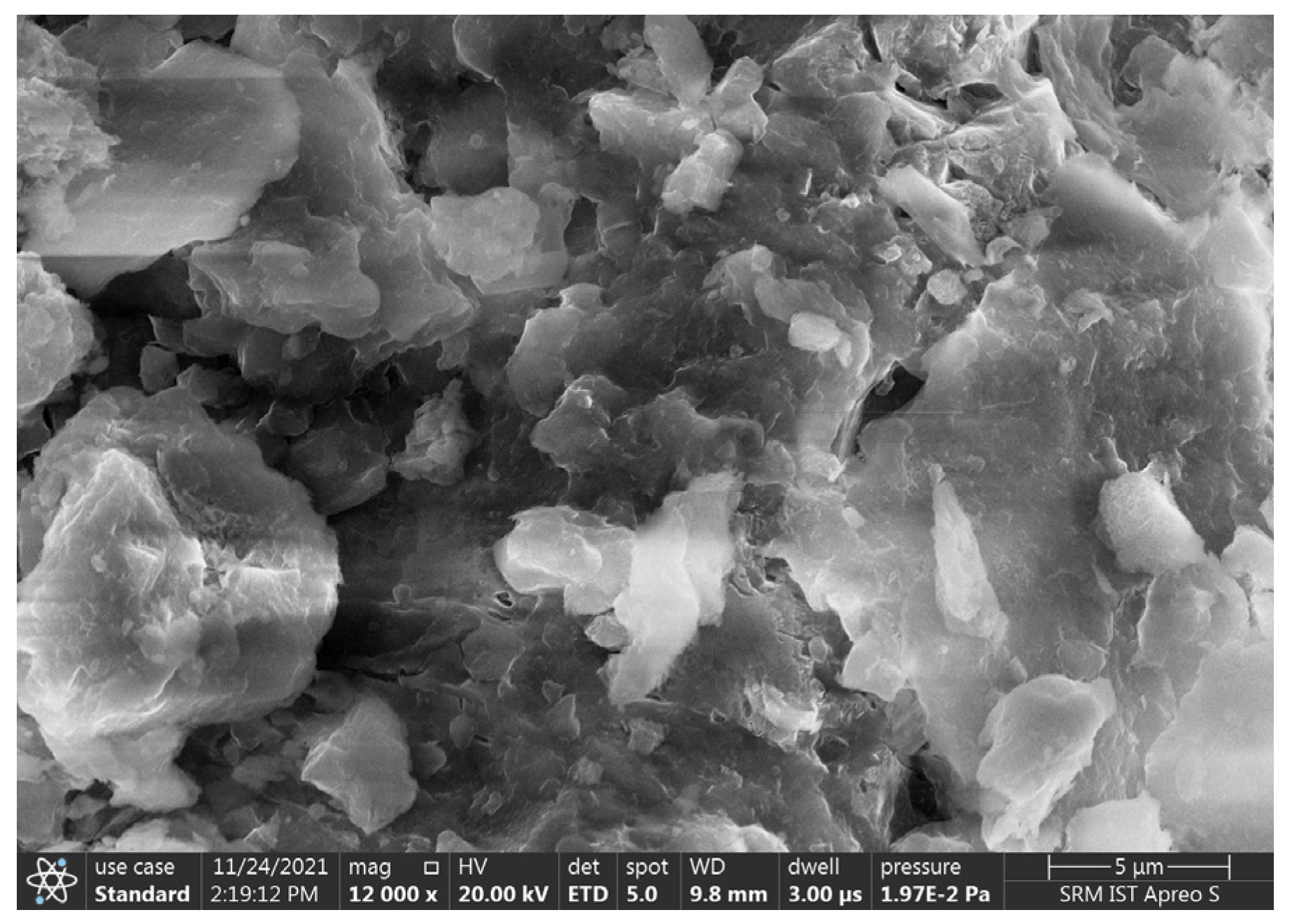

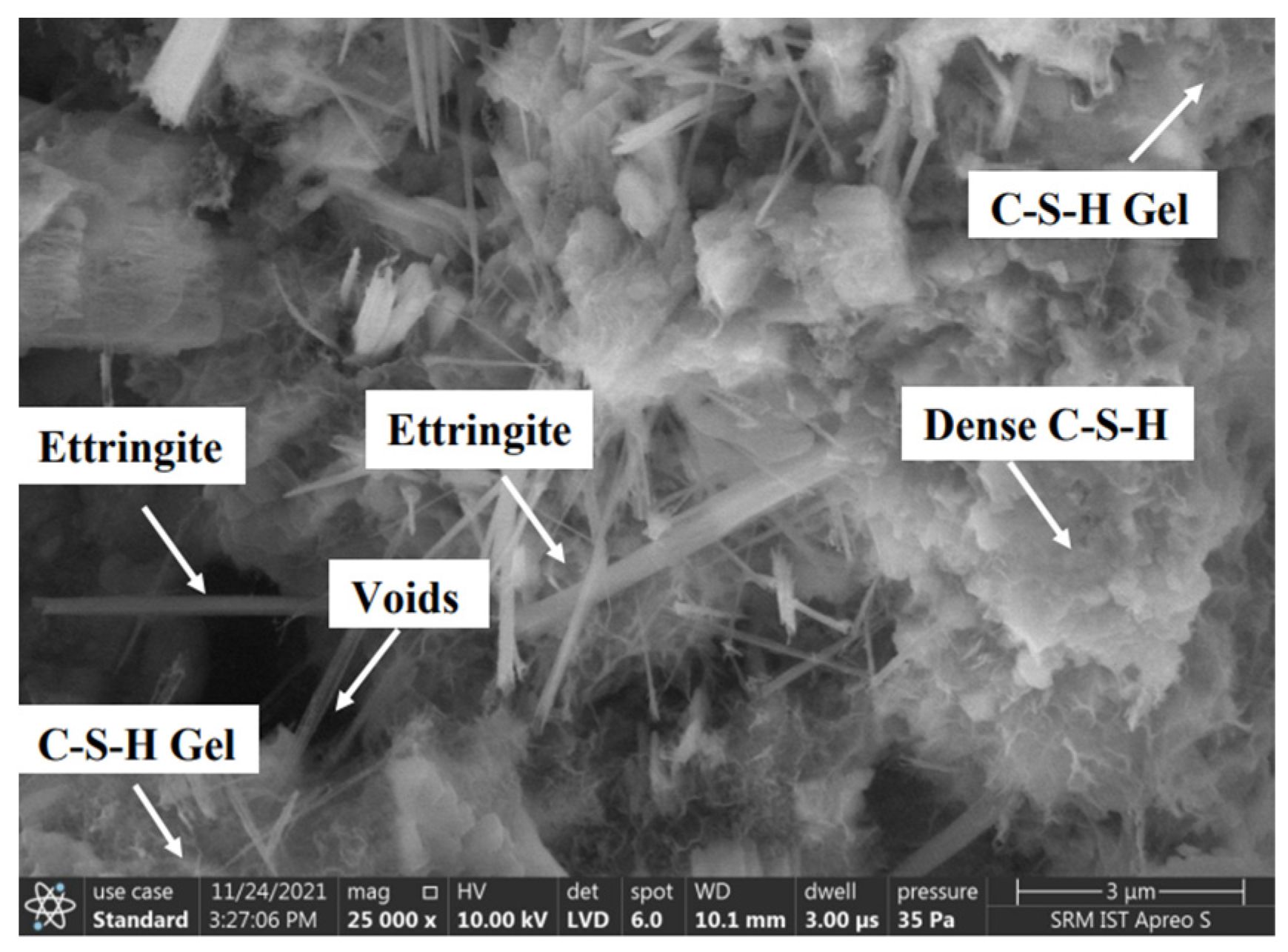
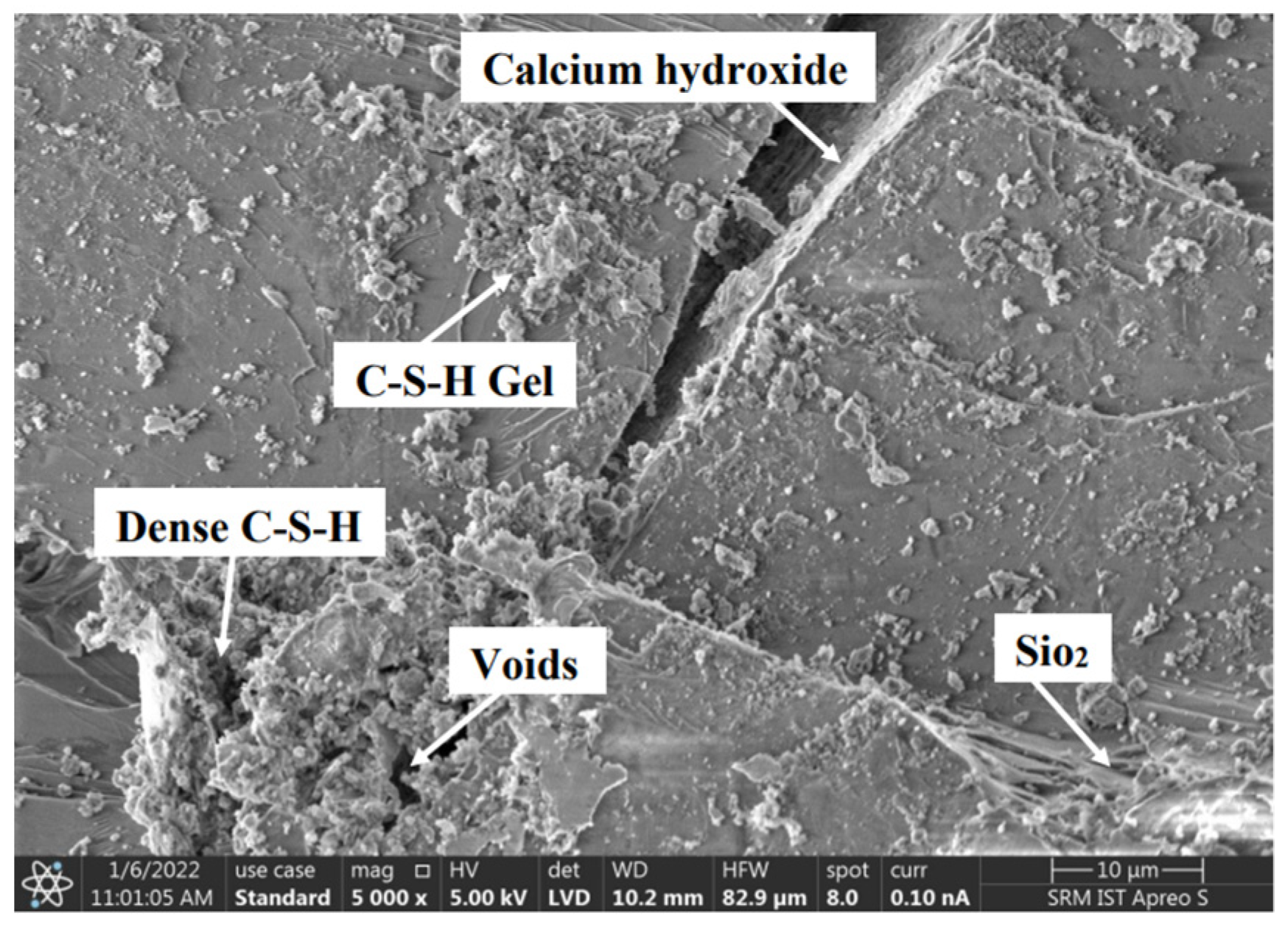
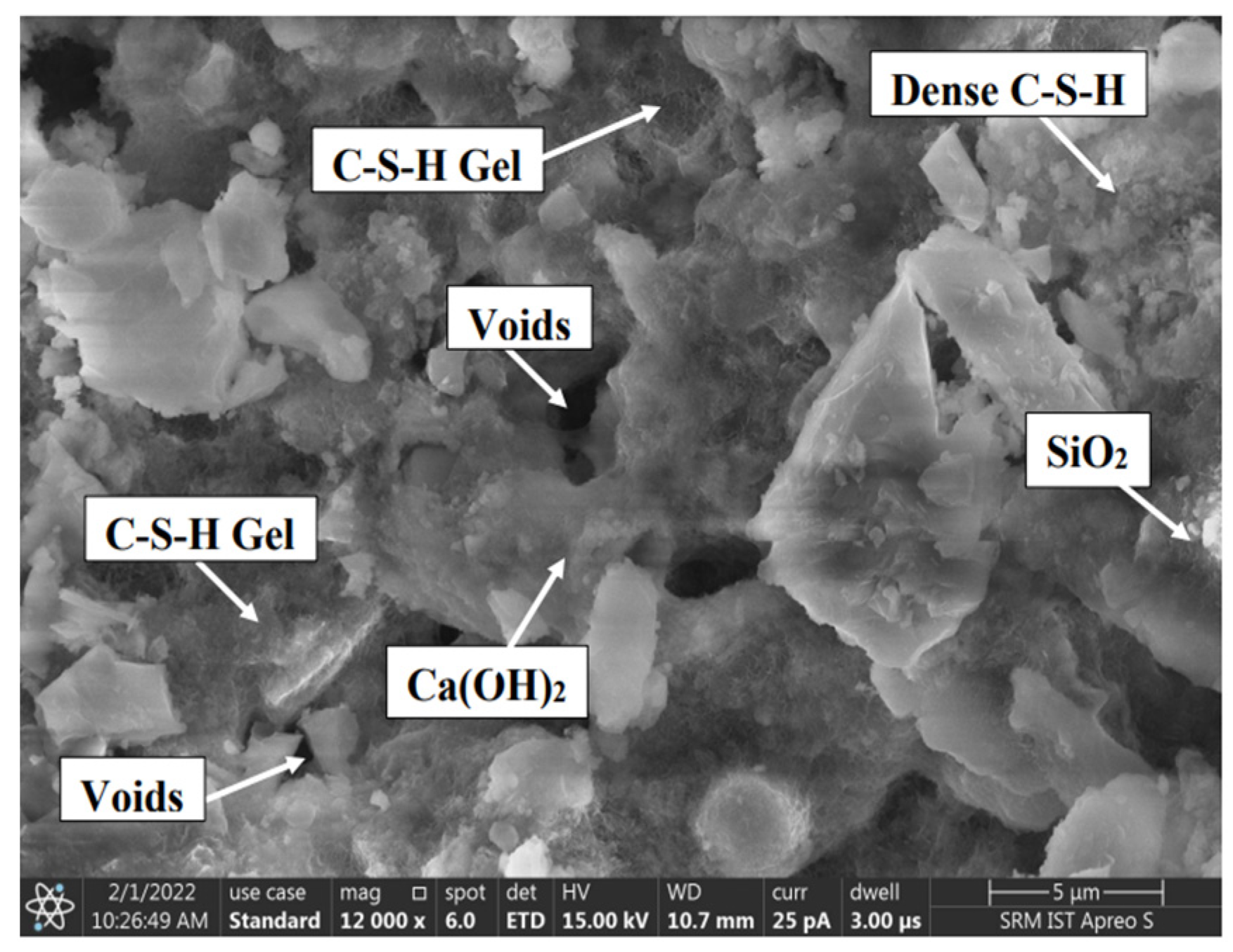
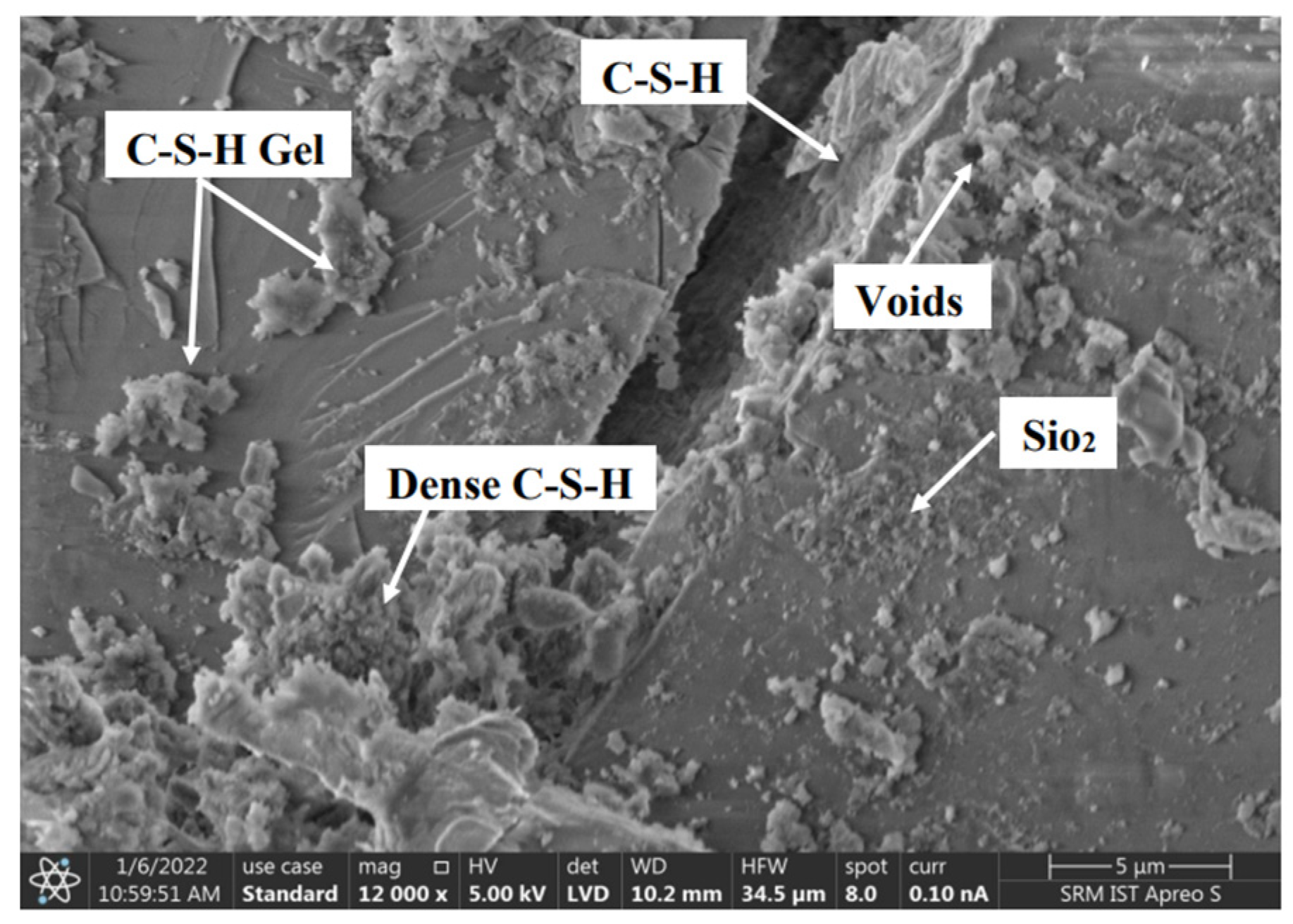
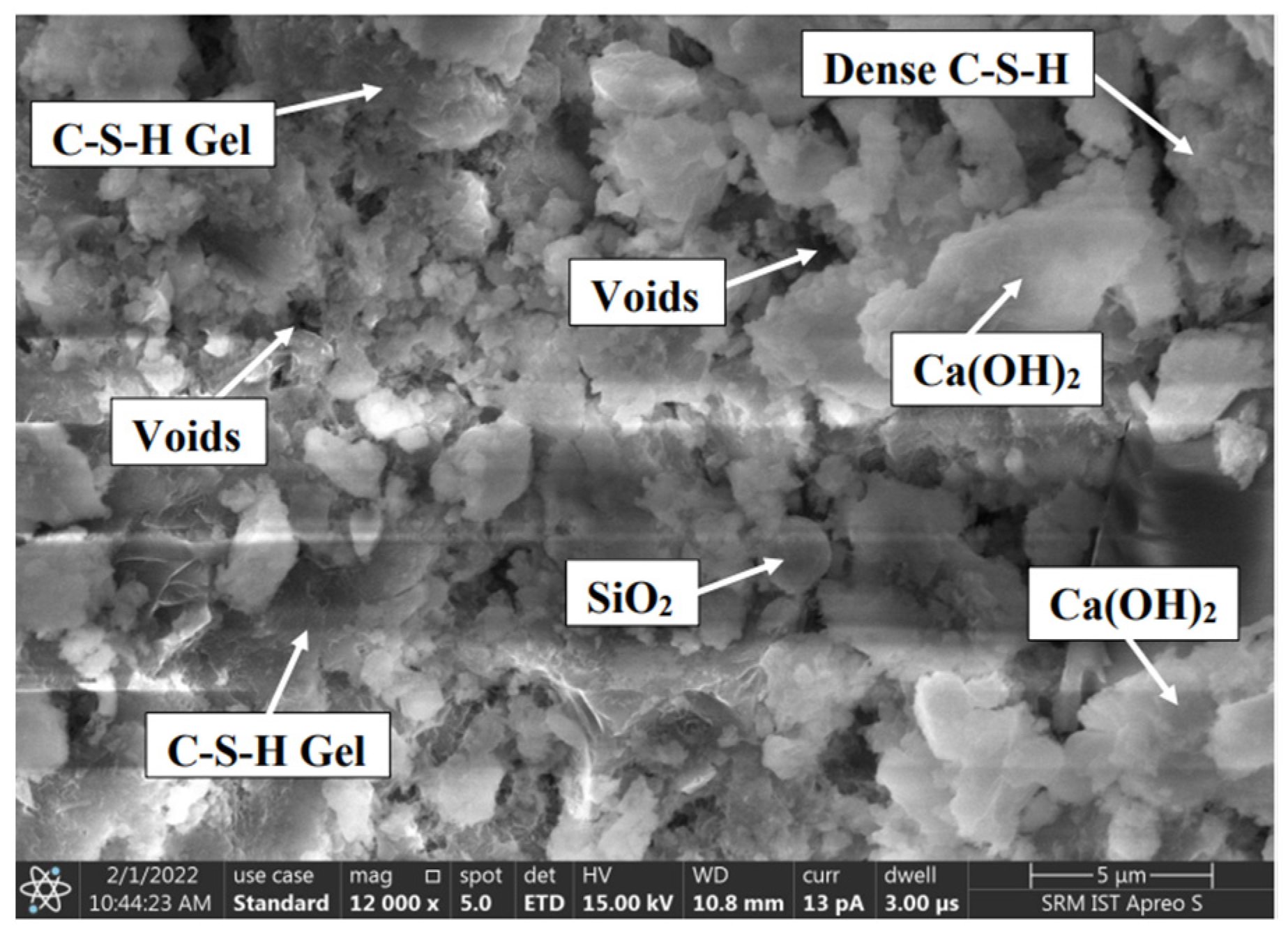
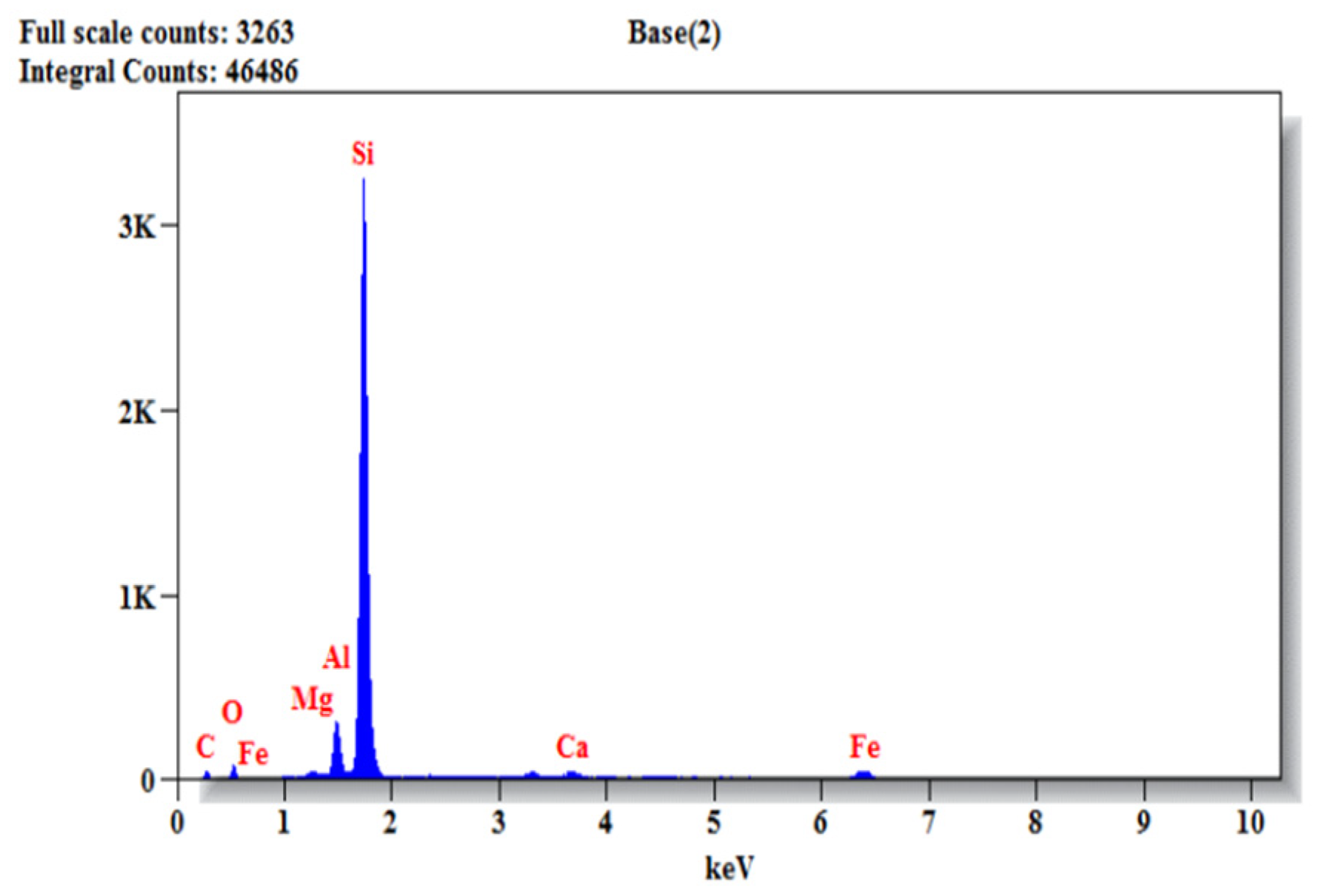
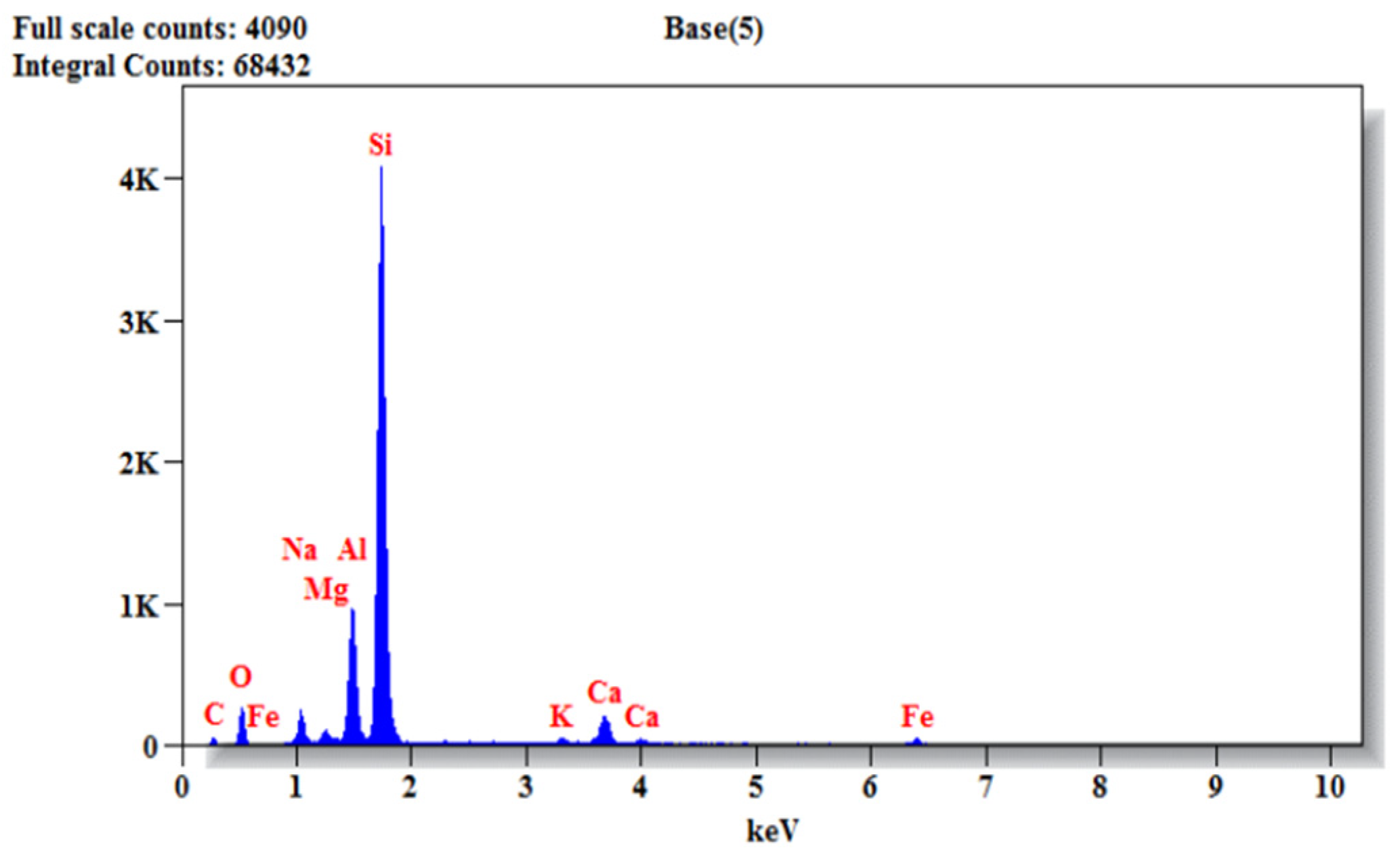

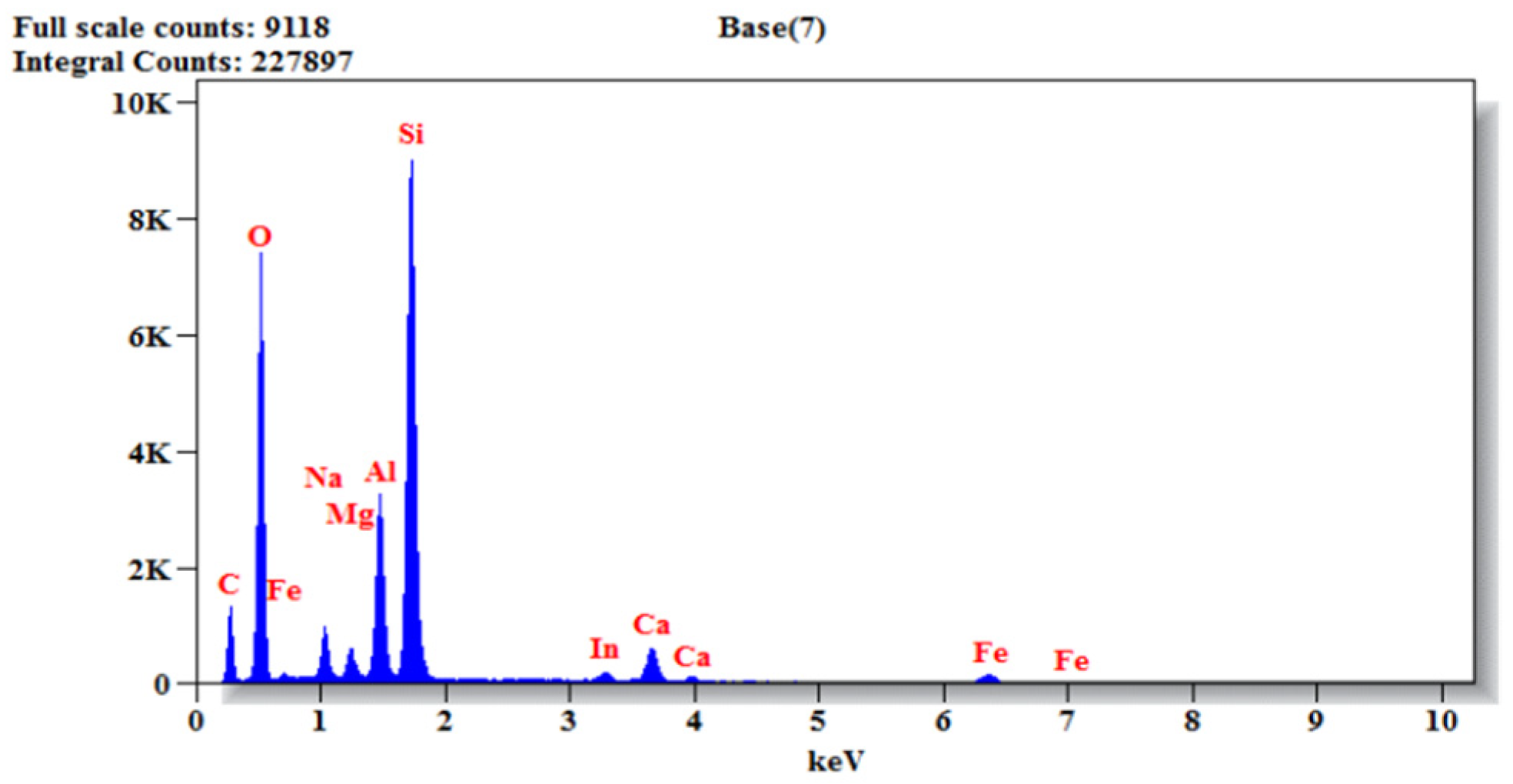
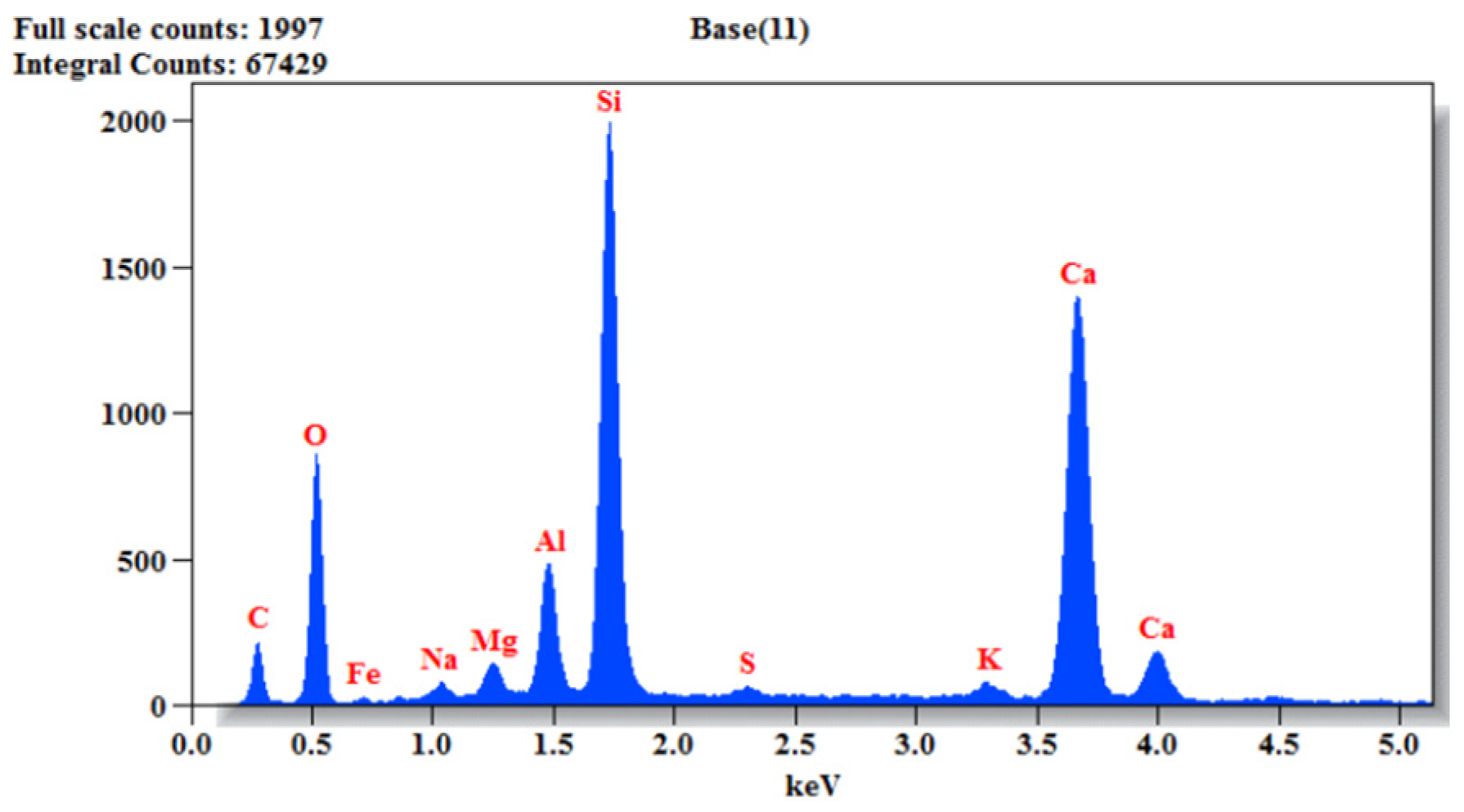
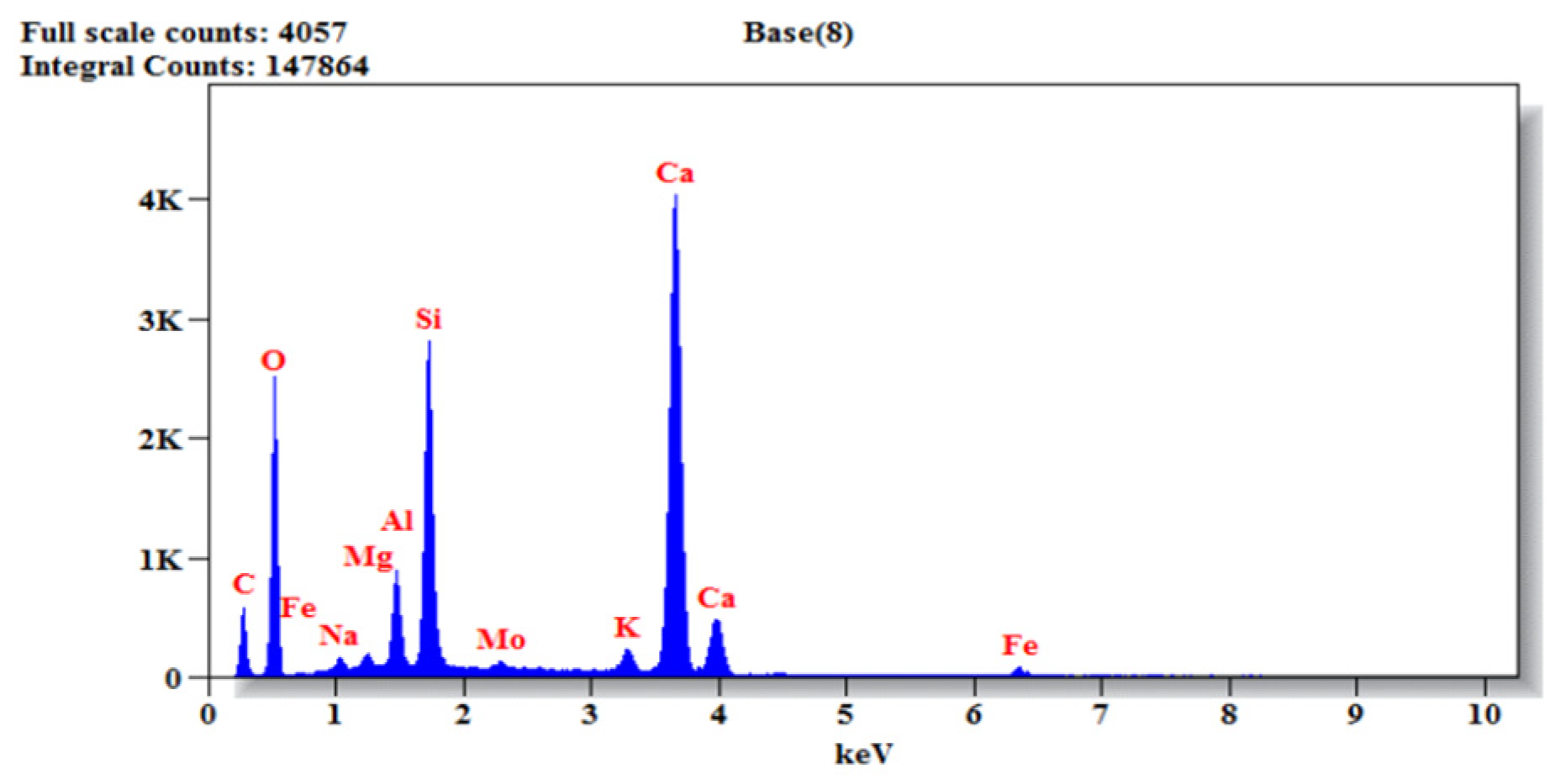
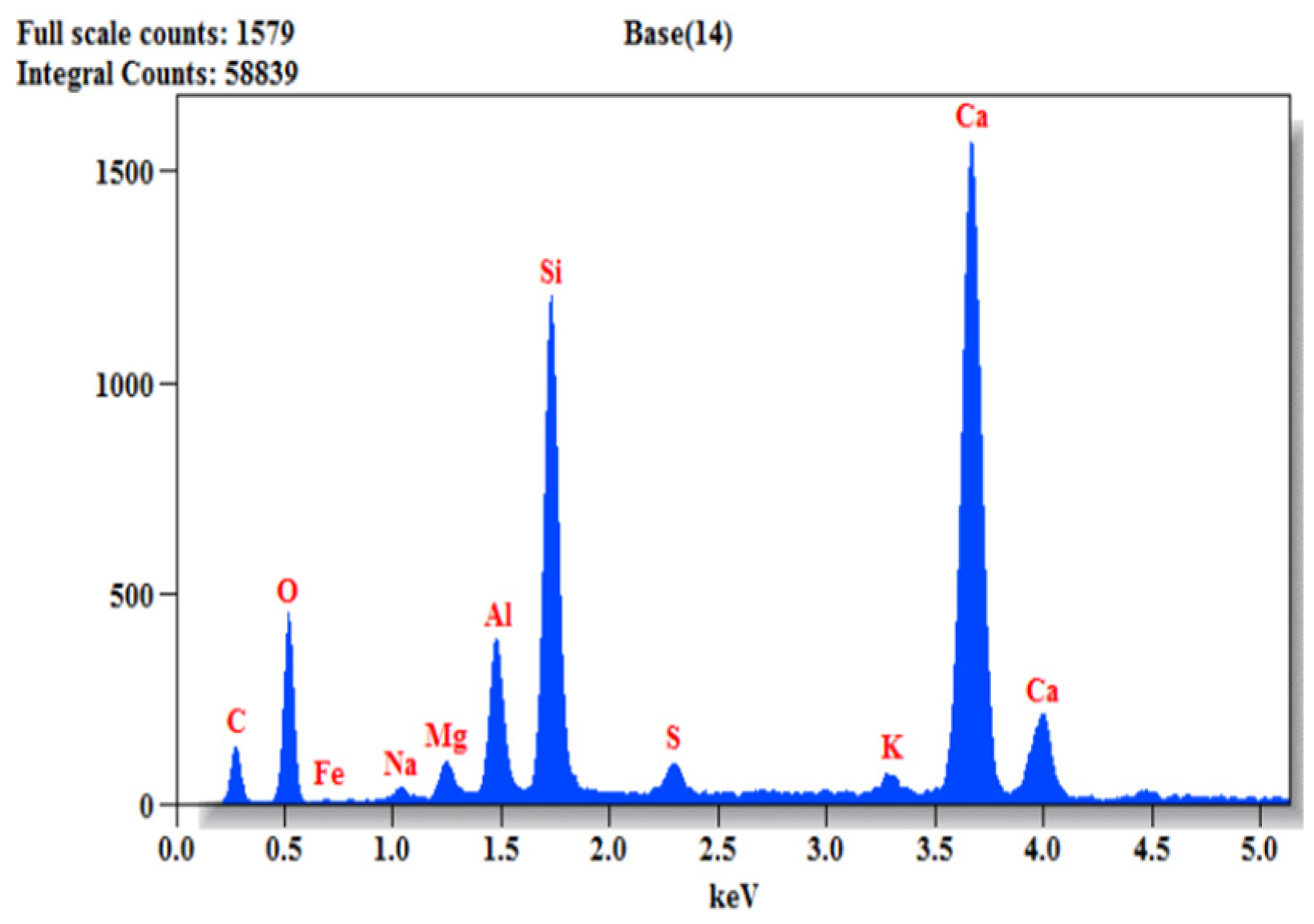
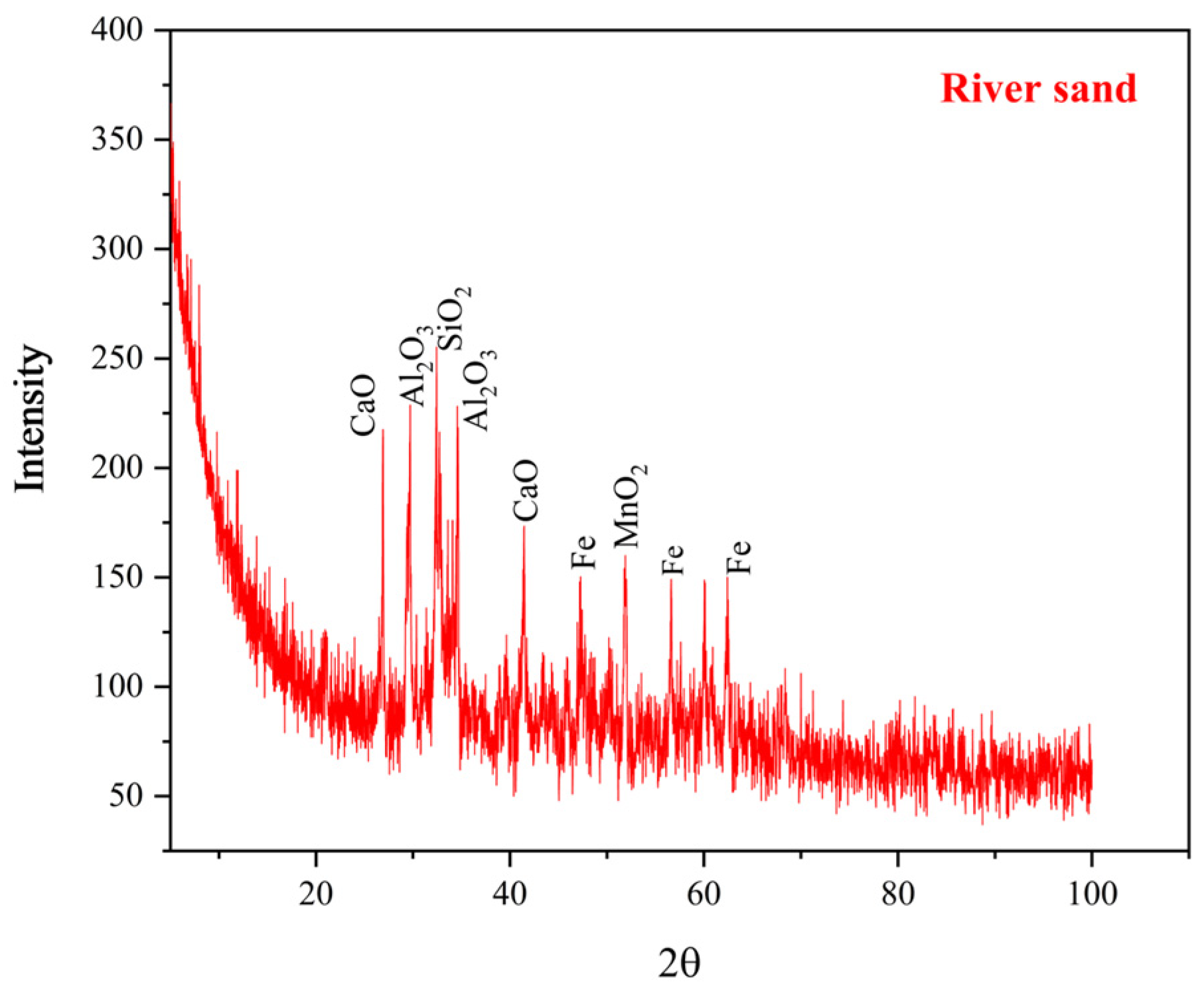
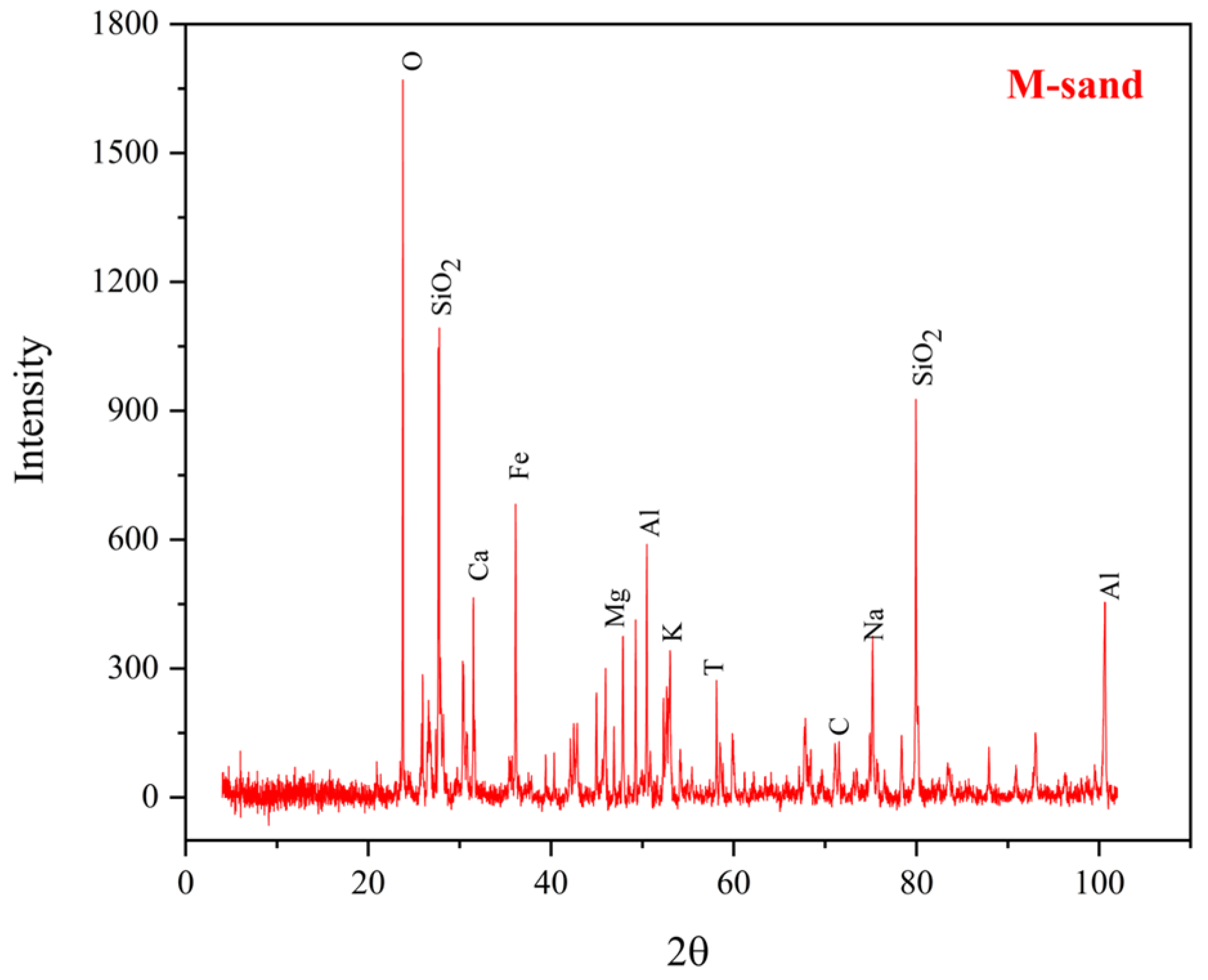


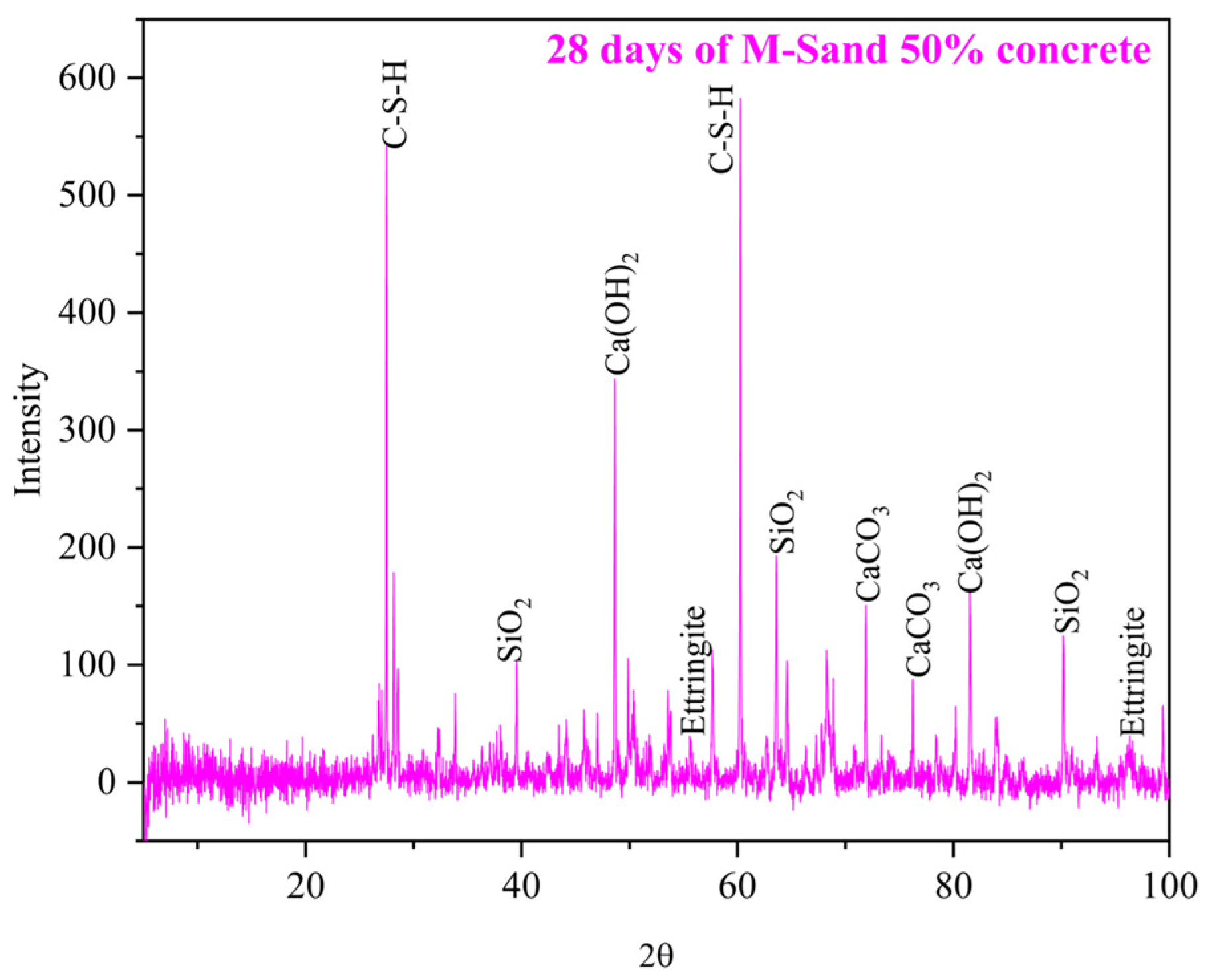
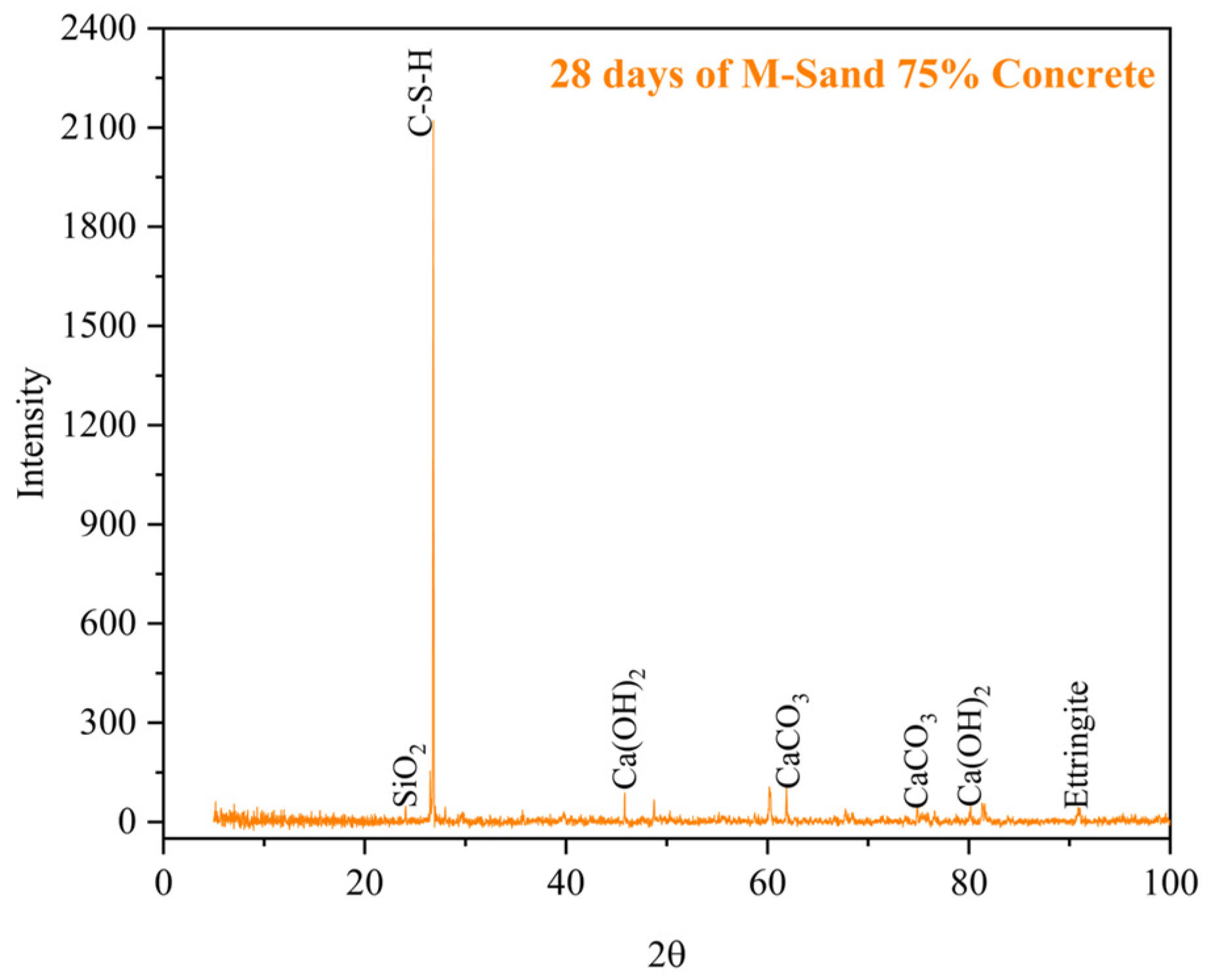
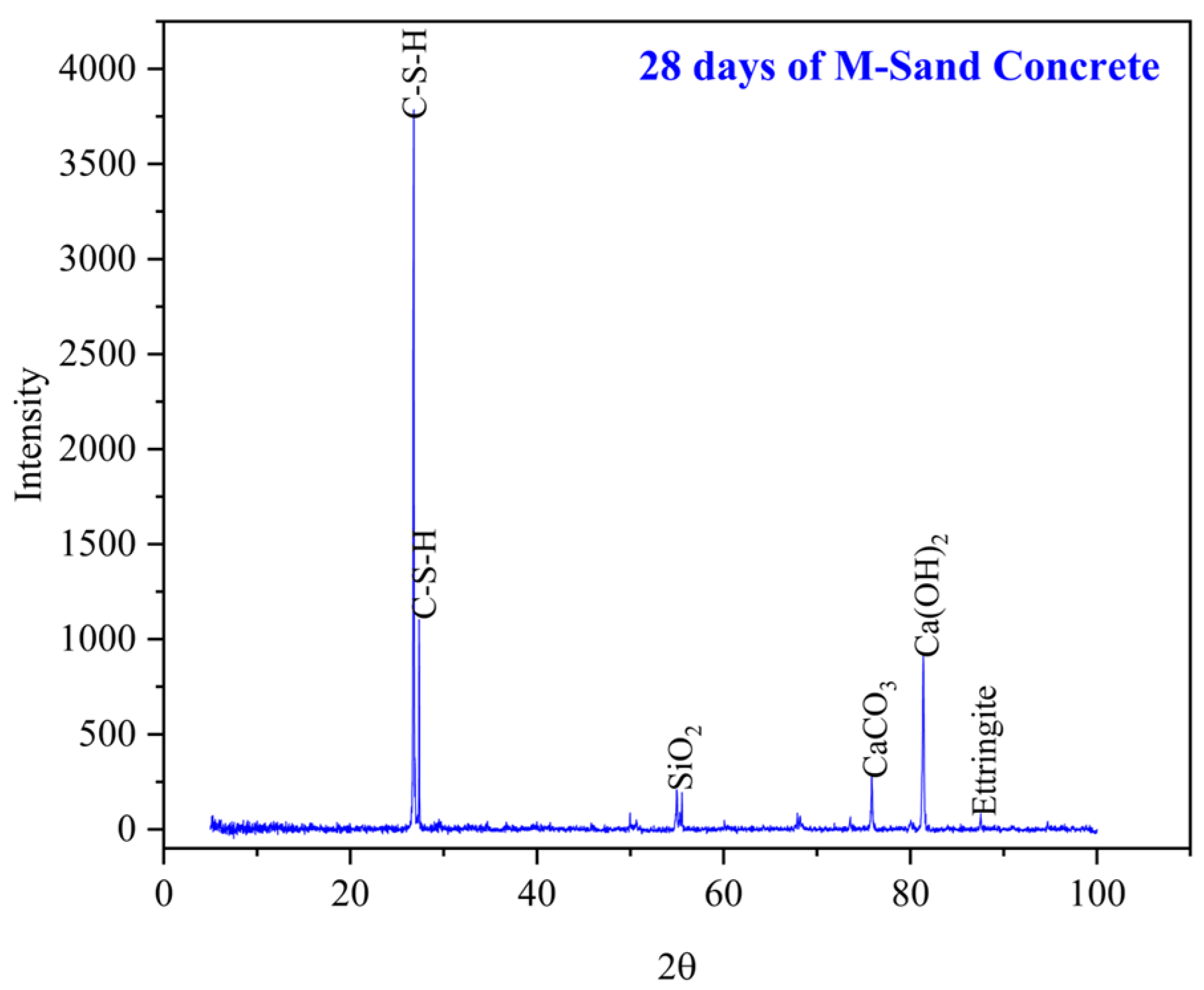

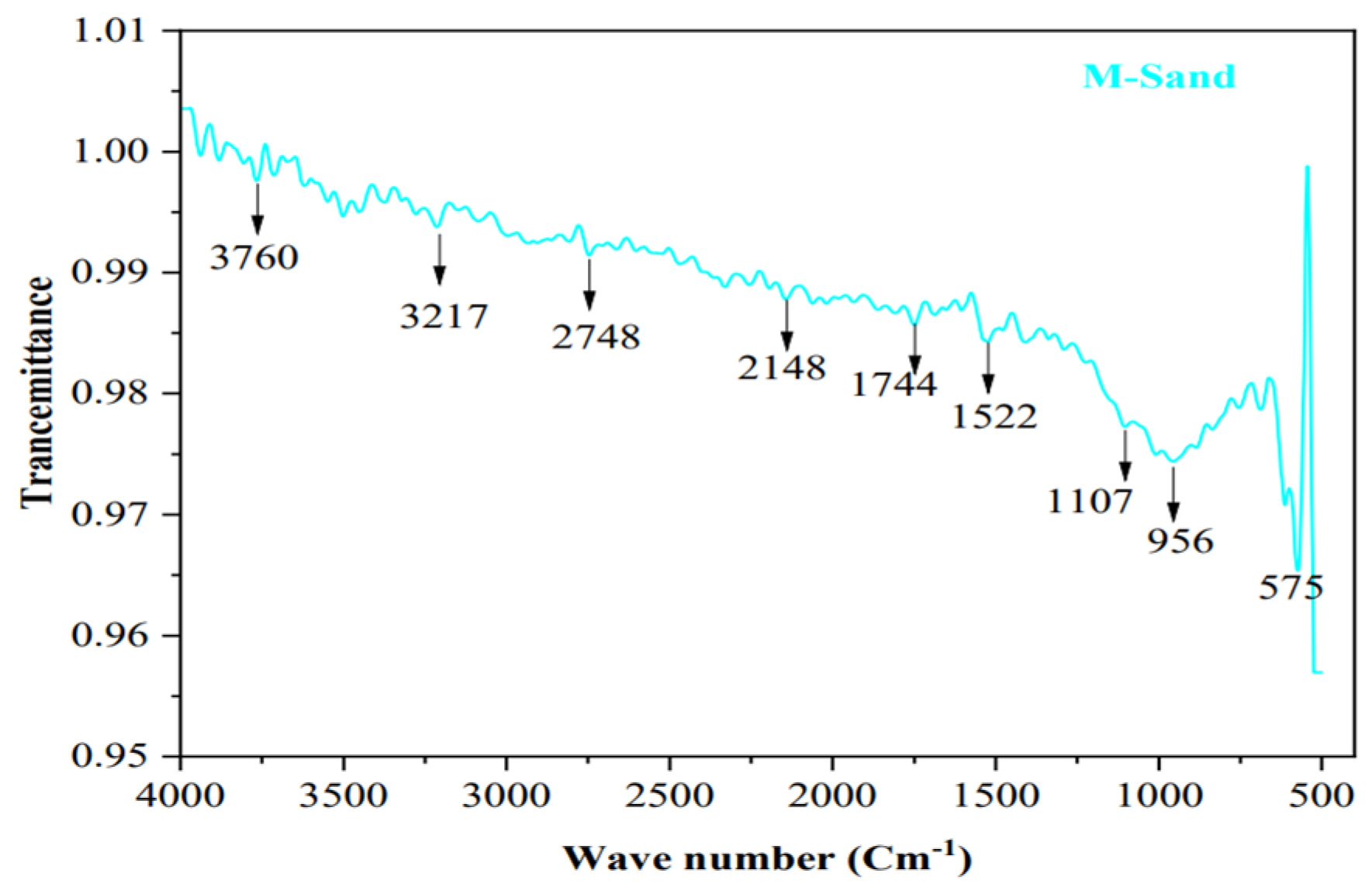


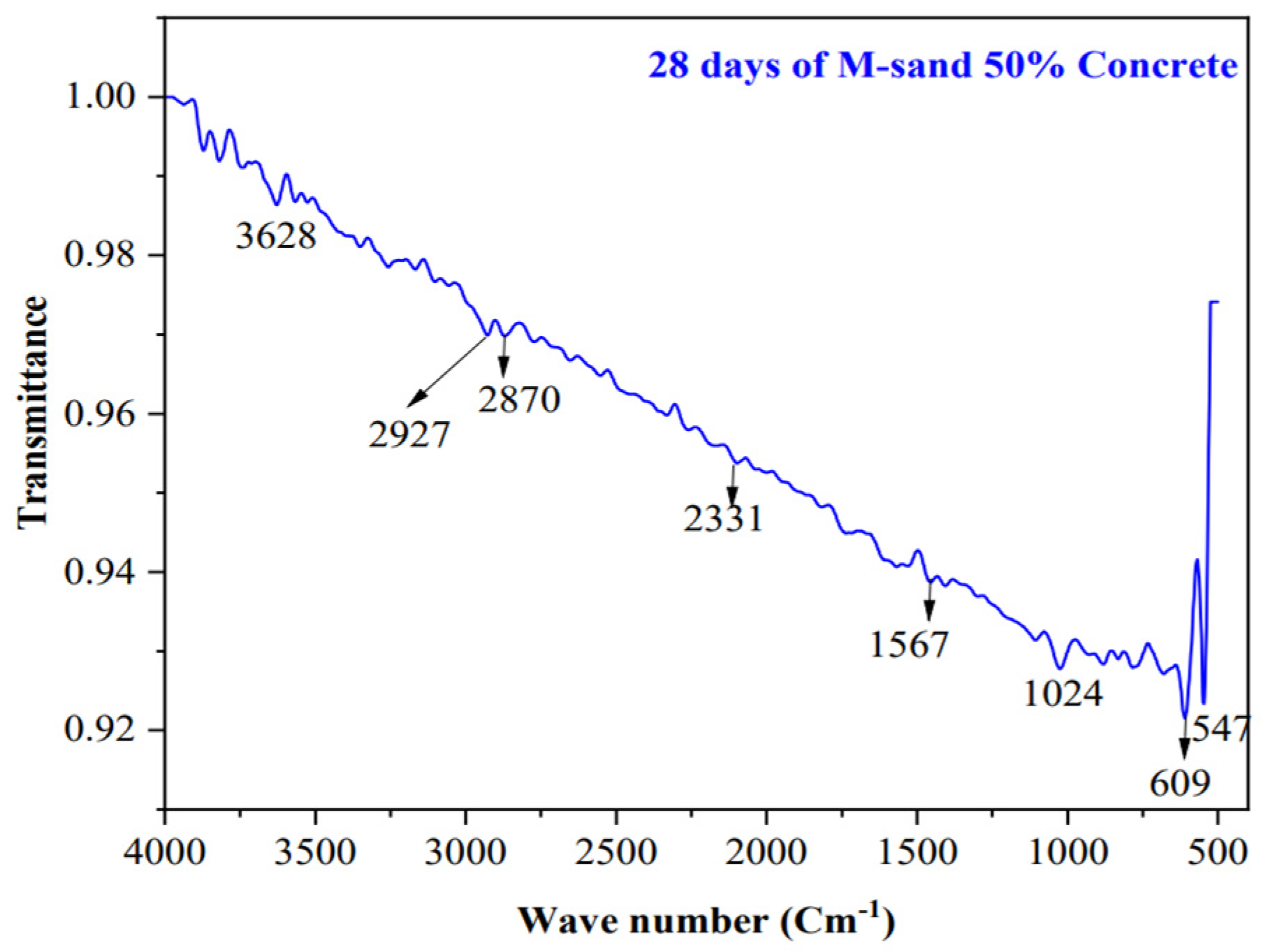

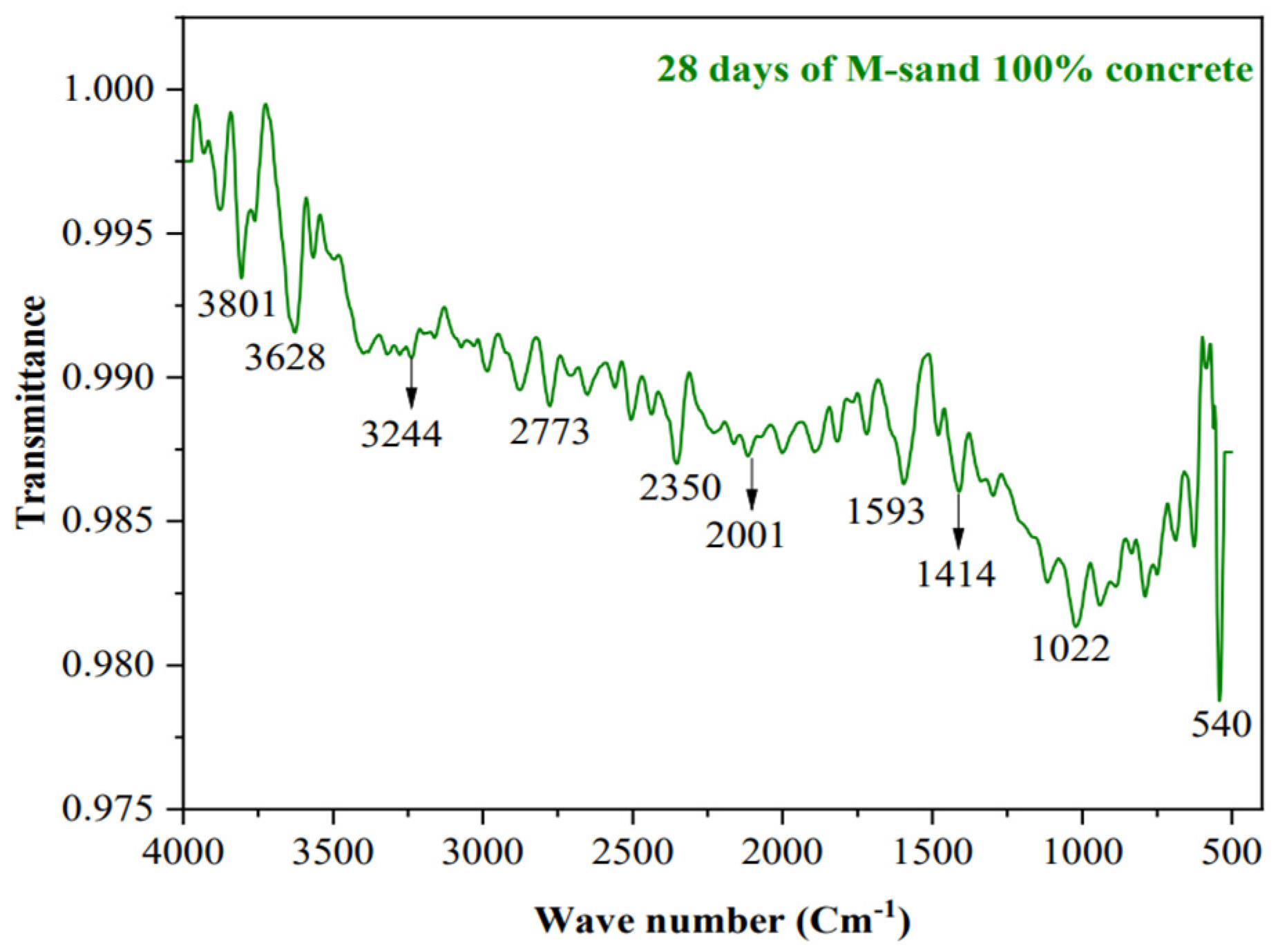
| Properties | Cement | Alccofine | Micro Silica | Conplast SP 430 |
|---|---|---|---|---|
| Specific gravity | 3.12 | 2.86 | 2.25 | 1.18 at 25 °C |
| Bulk density | 1140 kg/m3 | 680 kg/m3 | 130 to 430 kg/m3 | - |
| Consistency (%) | 32 | - | - | - |
| Initial Setting Time (min) | 30 | - | - | - |
| Final Setting Time (min) | 600 | - | - | - |
| Fineness (%) | 2.18 | - | - | - |
| Chemical Constituent (%) | Cement | Alccofine | Micro Silica |
|---|---|---|---|
| SiO2 | 22.2 | 37.51 | 93.0 |
| Al2O3 | 4.9 | 24.57 | 0.80 |
| CaO | 63.5 | 30.46 | 1.50 |
| Fe2O3 | 4.9 | 0.94 | 2.10 |
| SO3 | 2.2 | 0.19 | - |
| MgO | 2.6 | 6.25 | 0.82 |
| Na2O | 0.8 | 0.04 | 0.38 |
| K2O | 0.5 | 0.51 | 1.10 |
| Loss on ignition | 1.2 | 0.57 | 5.88 |
| Mixes | Cement | Alccofine 1203 | Micro Silica | River Sand | M-Sand | CA | Water | SP |
|---|---|---|---|---|---|---|---|---|
| SCC | 354 | 104 | 62 | 722 | - | 960 | 177 | 1.5% |
| SCCMS25 | 354 | 104 | 62 | 541.5 | 180.5 | 960 | 177 | 1.5% |
| SCCMS50 | 354 | 104 | 62 | 361 | 361 | 960 | 177 | 1.5% |
| SCCMS75 | 354 | 104 | 62 | 180.5 | 541.5 | 960 | 177 | 1.5% |
| SCCMS100 | 354 | 104 | 62 | - | 722 | 960 | 177 | 1.5% |
Disclaimer/Publisher’s Note: The statements, opinions and data contained in all publications are solely those of the individual author(s) and contributor(s) and not of MDPI and/or the editor(s). MDPI and/or the editor(s) disclaim responsibility for any injury to people or property resulting from any ideas, methods, instructions or products referred to in the content. |
© 2023 by the authors. Licensee MDPI, Basel, Switzerland. This article is an open access article distributed under the terms and conditions of the Creative Commons Attribution (CC BY) license (https://creativecommons.org/licenses/by/4.0/).
Share and Cite
Suriya, D.; Chandar, S.P.; Ravichandran, P.T. Impact of M-Sand on Rheological, Mechanical, and Microstructural Properties of Self-Compacting Concrete. Buildings 2023, 13, 1126. https://doi.org/10.3390/buildings13051126
Suriya D, Chandar SP, Ravichandran PT. Impact of M-Sand on Rheological, Mechanical, and Microstructural Properties of Self-Compacting Concrete. Buildings. 2023; 13(5):1126. https://doi.org/10.3390/buildings13051126
Chicago/Turabian StyleSuriya, D., S. Prakash Chandar, and P. T. Ravichandran. 2023. "Impact of M-Sand on Rheological, Mechanical, and Microstructural Properties of Self-Compacting Concrete" Buildings 13, no. 5: 1126. https://doi.org/10.3390/buildings13051126
APA StyleSuriya, D., Chandar, S. P., & Ravichandran, P. T. (2023). Impact of M-Sand on Rheological, Mechanical, and Microstructural Properties of Self-Compacting Concrete. Buildings, 13(5), 1126. https://doi.org/10.3390/buildings13051126





